






September • 2023 SATURDAY SEPT. 9 TH - 11 AM SUNDAY SEPT. 10 TH - 10 AM globalheroes.com
BY RAYE MOCIOIU
HOW MICHAEL "PINBALL" CLEMONS AND DIANE LEE CLEMONS ARE TRANSFORMING YOUTH EDUCATION





“If you want to show me a truly great person, don’t show me awards, money, or power,” declared Michael “Pinball” Clemons. “Show me what that person has done for someone else. Therein lies true greatness.”
It’s a message that he seems to embody in everything he does. With seven championships under his belt, the American-Canadian sports executive is one of the most distinct faces in Canadian football, and his impact on and off the field is a testament to his passion.
Nicknamed “Pinball” for his ability to effortlessly dodge would-be tacklers, the CFL legend’s career is proof of his boundless energy—which he continuously
A FAMILY MATTER
Twice honoured with the CFL’s Man of the Year Award, adorned with the Queen’s Diamond Jubilee Medal for Community Service, and a member of the Order of Ontario, Michael’s career is dotted with incredible achievements.
But a family man through and through, he says that his greatest joys have been his roles as husband and father—and his greatest inspiration has always been his mother, Anna Bryant.
“She was always there for me,” he said. “She only ever missed one football game, and her absence was for a church meeting.”
Michael shared that his mother demanded excellence in all areas—a fact he looks back on fondly, although he confesses that he did sneak a few Cs between his long line of As and Bs.
“Presence, excellence, and loyalty was the anthem she lived right before my eyes,” he said.
It’s an anthem that Michael continues to sing with his own family, supported steadfastly by Diane. A Juno nominee, TV and radio host, actress, and motivational speaker, Diane says that family plays a significant role in their work.
“My parents instilled in me the importance of compassion, empathy, and giving back to society,” she explained. “They taught me to be mindful of the needs of others and to use my resources and abilities to make a positive difference. They remind me of the power of hope, resilience, and the belief that even small actions can create meaningful change.”
Growing up in a family of 10, Diane remembers that it wasn’t always easy for her parents, making their commitment to giving much more meaningful.
“Even though we didn’t have much, I remember my mom always inviting entire families to dinner,” she recalled. “My mom volunteered with the community service at church and always welcomed anyone to our home that needed a bite to eat or just a listening ear. It sparked a desire within me to want to give back in my own way!”
Looking back, Diane shared that family values, both from her
uses for good. Now the General Manager of the Toronto Argonauts, the team and city he’s called home for so many years, Michael continues to share his infectious enthusiasm on the gridiron—but his impact extends far beyond the field. In 2006, he co-created the Pinball Clemons Foundation (PCF) with his wife, Diane Lee Clemons. With a wealth of fulfilling career opportunities and mentorship for engaged youth and years of grateful alumni, the PCF is proving that the power of education and hope can make an incredible impact—and they’re showing no signs of slowing down.
needs as situations arise. The new alumni program speaks to the unique demands of making and saving money and exploring career options as students become young professionals.
The You(th) Lead Conference, organized by the PCF, works to further this mission. Post-secondary students and business executives gather for a networking event where students can ask questions and converse with professional speakers, influencers, celebrities, executives, and industry leaders from Canada’s top companies.
“This platform provides our students with a unique opportunity to be in a room with leaders they may otherwise be unable to meet at this stage in their lives,” Diane explained. “And while the students have a great time, it may be said that executives have an even better one—there is nothing like being in a room of young people who are fueled by a lust for life and a passion for progress.”
upbringing and her husband’s, have informed how they have raised their children.
“From the time they could walk and talk, we’ve involved our girls in giving back and tried to nurture the values of empathy and compassion,” she explained. “They’ve visited shelters, joined us on our trips to Haiti and Africa, and are often present when we work in our community. We’ve tried to instill in them a lifelong commitment to positively impacting the world around them. More importantly, we’ve tried to lead by example by including them in our work.”
With family and faith as guiding principles, the couple, who were awarded the Meritorious Service Medal for their work, have turned their passion for giving into a foundation that is making a difference in the lives of young people.
GIVING IS LIVING
According to Michael, the PCF has one goal: to see hope in the eyes of every child. A career of winning and a lifetime of aiming for success has uniquely positioned him to lead the next generation of youth to greatness.
“My experience as a professional
athlete has made the foundation more focused on results, garnering consistent, sustainable outcomes that lead to independence for youth coming from underserved communities,” the former All-Star running back said. “We provide young adults with financial assistance, mentorship throughout their time in post-secondary or micro-credential programming, inhouse mental health supports, and career development counselling. The program also provides a job within 45 days of graduation.”
“I have made the Dean’s List after completing my Bachelor of Social Work. I could not have done it without all of your support and guidance. In my first degree, I was told that university was not for me, and yet, here I am on the Dean’s List. This is my greatest achievement. I am so grateful for every single one of you.”
—Brianna Montinaro, Masters in Social Work Graduate, Program Assistant at CAMH.
The focus on sustainability is paramount: the PCF is not a helping hand but a set of building blocks for a brighter
future, with ongoing support to keep youth on track.
Michael explained that youth have multiple levels of support, including a staff social worker, round-the-clock contact with their mentor, and career development support.
“We have incorporated a winning philosophy that embodies effort, education, and performance, maintaining a ‘help each other be right, not wrong’ mentality that challenges students to be their best,” Michael said.
THE FUTURE OF YOUTH
The PCF’s programming is comprehensive, taking care to equip students with the tools they need to succeed. The Clemons explained that the wrap-around support is multi-faceted. It includes online reviews to get to know the students’ needs, guidance to help them manage their workload, and mentorship to support them through schooling to graduation.
Michael shares that along this path, the PCF also brokers internships and structures career development, including resume prep, mock interviews, and workplace etiquette. This model continues to adapt to students’
The PCF will hold the fourth annual You(th) Lead Conference on November 25th at Hotel X in Toronto, kicking off a very busy season for the Clemons—the season of giving!

On December 6th, join Michael, Diane, and friends at Christmas with the Clemons at Roy Thompson Hall in downtown Toronto. The event will feature musical and artistic performances guaranteed to get you and your family in the Christmas spirit.

“Hosted by Michael and featuring performances by myself and friends, who in the past have included Jully Black, the Three Tenors, Keyshia Chante, and many more, this is an event that our foundation family now looks forward to annually,” said Diane. “I love this event. What better way to start the holiday season than by giving back to the tune of some of our favourite jingles?”
Tickets for Christmas with the Clemons go on sale on September 1st, but the mission to transform education is year-round. Visit pinballfoundation.ca to learn more and help provide marginalized and racialized youth with mentorship, education, and employment.
Published by IVY HOUSE MEDIA LIMITED. Headquarters: 2660 Sherwood Heights Drive, Suite 202 Oakville, Ontario • L6J 7Y8 - Office: 905-815-1500 info@globalheroes.com PUBLISHER Amir Shirazi EDITOR IN CHIEF Denise Koprich Shirazi EDITOR Raye Mocioiu CREATIVE DIRECTOR Sergio D. Spadavecchia GRAPHIC DESIGNER Kelly Laufer PRODUCTION MANAGER Allie Murray FINANCE DIRECTOR Marie LaVoie BUSINESS OPERATIONS MANAGER Jonathan Ramlal CONTRIBUTORS Raye Mocioiu, Allie Murray, Sherrye Wyatt, Lee Hart SALES DIRECTOR Stephen McDermott ADVERTISING Heibrie Barron, Coleby Smith, Daniel Sette, Barbara Lamarshe, Emile Galarneau, Kent Batson, Stephen Fletcher, Rick Morris Cover Photo © Skylite Images Fine Art Photo Studio
MICHAEL CLEMONS WITH STUDENT © SKYLITE IMAGES FINE ART PHOTO STUDIO YOU(TH) LEAD CONFERENCE APRIL 2023 © SKYLITE IMAGES FINE ART PHOTO STUDIO CHRISTMAS WITH THE CLEMONS 2022 - TORONTO MASS CHOIR, SONIA COLLYMORE AND DIANE LEE CLEMONS © SKYLITE IMAGES FINE ART PHOTO STUDIO MICHAEL AND DIANE LEE CLEMONS © SKYLITE IMAGES FINE ART PHOTO STUDIO The power of positive, solution-based journalism. globalheroes.com September • 2023
Challenging the Status Quo:
Branksome Hall’s Innovation Centre and Studio Theatre
“The schools of the future will use the potential of technologies to liberate learning from past conventions and connect learners in new and powerful ways, with new sources of knowledge, innovative applications, and one another.”
—United Nations Educational, Scientific and Cultural Organization
As parents, we want our children to have an education that keeps pace with this age of unprecedented disruption. Our educational systems require immediate transformational change to do just that. Stimulating that change is what Branksome Hall does best.
Leading from the front is a hallmark of the Branksome vision. Rejecting outmoded systems, Branksome maintains a critical eye on leading-edge pedagogy— building out skills-based programming that brings the real world into the school and its students into the real world. Branksome’s mission is to continually evolve,
anticipating what’s next and scaling up in advance. Great things happen when learning goes off-script and traditional classroom dialogue is rewritten.
We know the future belongs to original thinkers, problem-solvers, entrepreneurs and those fluent in the STEM skills (Science, Technology, Engineering and Math) increasingly prized in a digital economy. As one of the world’s preeminent girls’ schools, with a Liberal Arts, International Baccalaureate approach to curriculum, Branksome is cementing its reputation as a leader in innovative, STEAM-focused education for girls.
Closing the gender divide in STEM fields and entrepreneurship is critical. Women comprise barely 25 per cent of workers in the technology sector. At the executive level, just 11 per cent are women, according to new research from the National Center for Women & Information Technology.
Setting young women up for success in STEM fields and

beyond is a key priority. While the school offers an innovative curriculum including robotics, a business incubator program (the first of its kind in Canada in the JK – Grade 12 space) and three Innovation Hubs, extensions are required to further students’ ambition, curiosity and passion.

A $30-MILLION CAMPAIGN TO CLOSE
THE GENDER DIVIDE
That’s why Branksome Hall is set to launch the most ambitious fundraising campaign in its history. Funded by the $30-million Make Way Campaign launching this month, Branksome Hall has broken ground on the Innovation Centre and Studio Theatre (iCAST), a space where STEM and the arts will collide. It’s set to open in 2025.
THE ONLY BUILD OF ITS KIND AT THE JK TO GRADE 12 LEVEL IN CANADA
The visionary design of iCAST
is typically encountered only at the post-graduate level. iCAST will offer students a complete immersive education in skills most prized in tomorrow’s economies, where ingenuity and entrepreneurial spirit will be valued far more than pure knowledge.
Above all, iCAST amplifies opportunities to embrace experimentation, risk-taking and problem-solving. This “Innovator’s Mindset” sets up Branksome students for success with transferable skills far beyond entrepreneurship or engineering.
Top universities in Canada and globally have remarked that iCAST’s programming, and the competencies it produces, are exactly what they’re looking for.
“iCAST is offering a totally different frontier in education than I’ve seen,” said alum and Grade 4 parent Shelby Austin ’99. She’s currently the CEO of Arteria AI and a renowned startup expert at the top of her game. “I was a student who shined more when it had practical
relevance. iCAST puts practical at the heart and will help students understand and practise the skills of the modern world.” Thanks to iCAST and its mission to close the STEM gender gap, Austin will have a lot more company in the executive suites in the decades to come.
To learn more about Branksome Hall, visit branksome.on.ca

WHAT’S INSIDE?
Fabrication & Digital Spaces (Machine, Wood & Robotics Workshops)
Pitch Space Theatre with 2,550 sq. ft. Tension Grid
AI an d Augmented
Reality Labs
Home of Noodle (Business Start-Up Incubator)
At Branksome Hall, we’re fostering the next generation of leaders and thinkers who will break down barriers and influence the future, their way. It means reimagining education, fostering an innovation mindset and putting collaborative learning into action. As the only independent school for girls with an IB curriculum for Junior Kindergarten to Grade 12, we’re giving our students the confidence to take their futures by storm, making us proud to say: “A Branksome girl did that.”
CAST RENDERINGS - ROBOTICS STUDIO © COURTESY OF BRANKSOME
globalheroes.com ADVERTORIAL September • 2023
HALL
LITERACY IS MORE THAN READING AND WRITING
It’s being able to understand the printed word, put it to use, and engage fully in activities and opportunities at home, at work, and in the community.
Volunteer today!
Learn more at unitedforliteracy.ca
United for Literacy: Canada’s Literacy Connection

Taylor was three years sober from an addiction that had taken everything from him, including his education. He did not finish high school and lived on the streets for several years. Taylor worried about how he would find and keep a job. He searched the web for answers and found


United for Literacy, a national charitable literacy organization dedicated to improving the lives of children, youth, and adults through free literacy programs.
Taylor wanted to get his high school diploma but knew going back to school wasn’t suited for him. He joined the
New Directions program in Toronto, where tutors provide literacy, basic skills upgrades, and GED (General Equivalency Diploma) preparation. His goal was to get into the building trades, such as electrical or carpentry. For young people like Taylor, United for Literacy can be life-changing. After doing virtual classes and working at his own pace, Taylor gained the confidence and skills he needed to get his GED. Today, he is working his way to becoming a pipelayer.
Literacy is misunderstood in Canada. There is a perception that high literacy rates equate to most of the Canadian population, which is not necessarily the case. In fact, one in five adults in Canada struggles to read basic sentences or fill out a form—which makes it difficult or impossible to navigate everyday life.
Literacy touches virtually every aspect of our lives and has a great influence on our well-being.
“Literacy has changed my life in so many ways. Ever since I
was a young child, I had a fascination with reading books.
I used to skip high school to spend my days in the public library, immersing myself in other worlds, escaping my own reality. Reading and writing have given me a safe haven and have saved my life more times than I’d care to count. To me, literacy means protection, happiness, and confidence. It means skill building and understanding. The feeling of having a bright life and future ahead is a very tangible thing to me now. For someone who feared his future and succumbed to the depths of unfathomable darkness, knowing that I am supported and have an actual future ahead of me is something priceless that words cannot describe,” Taylor explained.
Literacy is the foundation of all learning. Everyone can learn, but not everyone has access to the support they need. Through a network of trained employees and volunteers, United for Literacy offers free tutoring to adults, youth, and children who
need extra support to succeed in the mainstream school system, in the workplace, or in life.
“I take pride in knowing that I am helping people gain valuable literacy skills and a new perspective on the possibilities for their lives,” explained a volunteer tutor.
Canada continues to face unprecedented challenges to literacy due to school disruptions caused by COVID-19 and the demands for an increasingly sophisticated understanding of written language to fully participate in daily life. Early gaps in schooling or socio-economic factors mean many people are playing “catchup” from the beginning. United for Literacy’s learner-centred approach—tailored to a person’s skills, interests, experience, culture, and goals—engages them in deciding what they want and need to learn.
Literacy changes everything. Be a part of the change and get involved today.
Learn more at unitedforliteracy.ca
25 Years of Promoting Canada's Official Bilingualism
A hub for diversity, Canada is one of 55 countries worldwide that is officially recognized as bilingual, with over 40 per cent of residents speaking two or more languages (as of 2021)*. Bilingualism comes with benefits: Studies have shown that bilingual people have strengthened cognitive abilities, are more creative, and find it easier to focus on multiple tasks.
Being bilingual opens not only professional doors, but personal doors, too—being able to communicate in more than one language allows for stronger and more diverse social and intercultural connections and access to cultural content in the form of music, films, books, and more in their original languages.
French for the Future, a national non-profit organization, recognizes that bilingualism is at the heart of Canadian identity and is the foundation of Canadian social cohesion and diversity. The organization inspires a passion for Canada's official bilingualism among youth from Grades 7 to 12 through programs and conferences.


For a quarter of a century, French for the Future has been at the forefront of promoting Canada's
official bilingualism, providing invaluable opportunities for students across the nation to explore the rich tapestry of languages and cultures that define Canada. What sets French for the Future apart is its unwavering mission to make all its programs accessible and free, ensuring that no student is left behind.
EMBRACING DIVERSITY
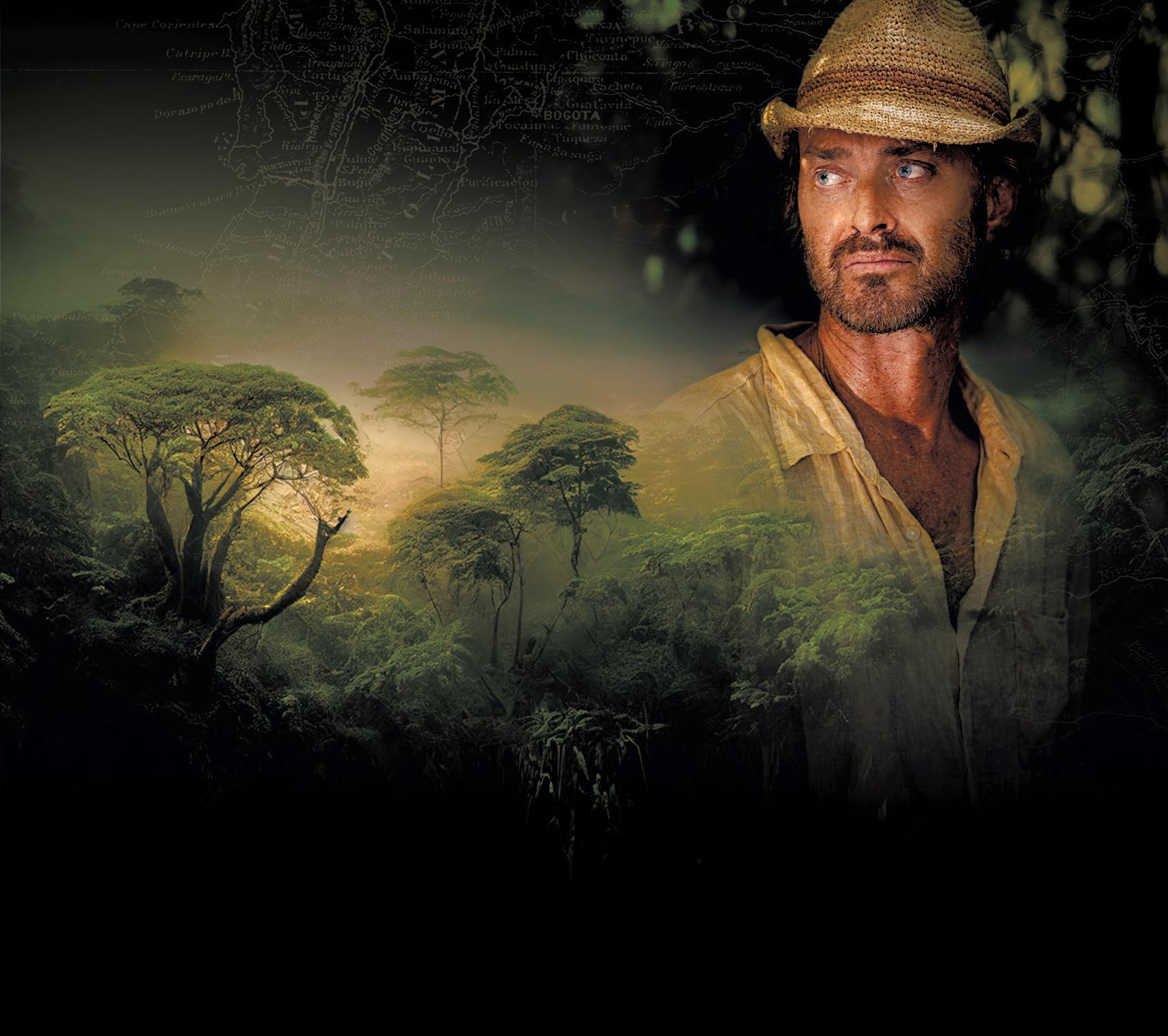
Language serves as a bridge between communities, forging social and intercultural connections that transcend borders. Canada's commitment to bilingualism allows for meaningful interactions between English and French speakers, fostering understanding and empathy.
Through French for the Future's initiatives, approximately 40,000










students annually are exposed to the beauty and cultural richness of the French language. This exposure not only enhances their linguistic skills but also nurtures their capacity to empathize with Francophones both in Canada and around the world.
French for the Future is constantly expanding its array of programs to provide even more opportunities for Canadian students. The organization awards $377,000 in scholarships annually through its National Essay Contest, open from October to December every year, motivating young individuals to continue their education in French at the post-secondary level. Additionally, the 15 Local Forums held across the country, including in Toronto and Ottawa, bring together
hundreds of young Francophones and Francophiles to explore the abundant opportunities offered by bilingualism. Online, the organization provides Fr+, a digital space for 14 to 17-year-olds to interact with others their age on topics that matter to them, in French!
FOSTERING BILINGUAL BRILLIANCE
A new school year marks new learning opportunities. French for the Future has three programs open for students as of this month.
Franconnexion Session
The Franconnexion Session, with its educational toolkit downloaded over 3,000 times, has become a valuable resource for teachers eager to motivate French learning in their classrooms. This program connects students to the beauty of the French language and culture, igniting their passion for bilingualism.
United Bilingual Correspondents
Through United Bilingual Correspondents, French for the Future successfully matches hundreds of students throughout Canada, facilitating meaningful
connections and cultural exchanges. This initiative strengthens bonds between English and French speakers, nurturing a sense of unity across the country.
Contest: Lance ton balado (Launch your podcast)
This exciting contest encourages students to showcase their linguistic skills and creativity by launching podcasts in French. By providing a platform for expression, French for the Future empowers young voices and encourages them to share their unique perspectives with the world.
Beyond these initiatives, French for the Future's commitment to nurturing bilingual ambassadors continues through the National Ambassador Youth Forum. This program trains young individuals to advocate for bilingualism and the French language, ensuring that the torch of linguistic diversity is passed down to future generations.
Using French outside of the classroom can be easy, fun and free. Visit french-future.org to learn more.
*STATISTICS CANADA, 2022 © COURTESY OF FRENCH FOR THE FUTURE FUN & FREE PROGRAMS IN FRENCH FOR STUDENTS IN GRADES 7 TO 12 DISCOVER OUR PROGRAMS
TAYLOR © COURTESY OF UNITED FOR LITERACY The power of positive, solution-based journalism. globalheroes.com ADVERTORIAL ADVERTORIAL September • 2023
The Fight for Clean Water: Canadore College Leads the Way
Canadore College is taking bold strides in tackling systemic issues surrounding clean drinking water in Indigenous communities. In collaboration with the Government of Canada’s Federal Economic Development Agency for Northern Ontario (FedNor), Canadore College recently celebrated the grand opening of its Water Teaching Lodge—a remarkable facility that combines traditional Indigenous teachings, cutting-edge technologies, and land-based research practices to provide sustainable solutions and increase awareness about the importance of water.
Reflecting the rich cultural heritage of the Anishinaabe people, the Water Teaching Lodge has been named Mshibizhiwgamig, which translates to Great Lynx Lodge in Anishinaabemowin. Mshibizhiw, the Great Lynx, is regarded as a water protection spirit that resides in lakes and underground rivers and is revered by the Anishinaabe people for its role in providing medicine and protection. The meaning and
PROMOTING SUSTAINABLE SOLUTIONS
Situated at Canadore’s College Drive Campus, the Water Teaching Lodge is intricately connected to The Village, the School of Indigenous Studies, the School of Environmental Studies, and the Innovation Centre for Advanced Manufacturing and Prototyping (iCAMP). Serving as a vital component of the Clean Water Initiative, the Lodge aims to incorporate Indigenous teachings, technologies, and landbased research practices related to water protection.
Judy Manitowabi, the Director of the First Peoples’ Centre at Canadore College, emphasized the Lodge's significance, stating, “The opportunity to learn and share stories with a focus on the significance of water will remain a priority. Water is life, and is a living being with its own spirit and must be respected.”
The Water Teaching Lodge and the construction of an operational water treatment facility on campus mark a significant shift towards
space where learners, partners, and Indigenous communities can access educational tools and deepen their understanding of water from an Indigenous worldview.
“Canadore has an obligation to be a centre for teaching and learning that ensures our students are connected with issues in the real world,” said Shawn Chorney, Vice President of Strategic Infrastructure, Indigenous and Learner Services at Canadore College. “The Lodge is a collaboration between Canadore and the private sector to be a catalyst for change. We need to offer new, custom solutions for water so we’re not perpetuating existing challenges."
In keeping with the goal of offering new solutions, the Lodge promotes technological advancements in water treatment and protection in addition to cultural teachings. Canadore College has constructed an operational water treatment facility on campus, showcasing state-of-the-art technologies such as ultrafiltration membranes, cartridge filtration, ultraviolet radiation, chlorina-
providing an immersive learning experience for students and community members.
A HUB FOR INDIGENOUS KNOWLEDGE
Canadore College, renowned for its applied learning, leadership, and innovation, offers over 80 full-time quality programs, attracting students from nearly 400 Canadian communities and 15 international countries. With its dedicated faculty and success services, the college contributes approximately $402.5 million to the Nipissing Parry Sound service area economy. Around 1,000 students graduate each year from Canadore, joining a network of 60,000 alumni who are making a difference worldwide. The college relies on its own innovation, entrepreneurial endeavours, and generous donors, receiving less than half of its traditional funding from the provincial Ministry of Colleges and Universities. By establishing the Water Teaching Lodge and the Clean Water Initiative, Canadore College not only addresses the


an Indigenous perspective.
To ensure the project aligns with the needs and values of Indigenous communities, Canadore College has established the Clean Water Initiative Advisory Council (CWIAC). Comprising Indigenous community members, water operators, and Canadore employees, the CWIAC plays a vital role in guiding the initiative, incorporating traditional knowledge, respecting community concerns, and embracing Indigenous values. This collaboration between Canadore College, government entities, tribal councils, and industry partners creates a space for innovation, technical support, and sustainable solutions, and represents a significant step toward addressing systemic challenges in Indigenous water management.
By combining Indigenous teachings, cutting-edge technologies, and community engagement, Canadore College is paving the way for sustainable and equitable access to clean drinking water for all.

TODAY’S
At Canadore, you are part of something. Find out more about Canadore College’s programs and initiatives at canadorecollege.ca
PREPARING
STUDENTS TO BE TOMORROW’S LEADERS
We believe in 360-degree student development. From finances to family life, we have supports in place to help you every step of the way.
© COURTESY OF CANADORE COLLEGE globalheroes.com ADVERTORIAL September • 2023
We have quality programs and award-winning professors to help train you for your future career.
Bilingualism Makes Canada a Oui Bit Better
"Speaking English and French is really important for my children and their future. It's one of the things that makes Canada great." This quote from Denise Massie, a parent of two boys and the volunteer President of the Ontario Branch of Canadian Parents for French (CPF), captures the sentiment and priority that many parents have placed on official language bilingualism across the country.
From preschool through elementary, secondary and post-secondary, there is a spirit of collaborating and new energy for creating opportunities for becoming a French/English bilingual. CPF is the leading source of support for families who want their children to benefit from speaking French as their second official language. Research shows that those benefits are improved memory, abstract thinking, flexibility, creativity and cross-cultural awareness, in addition to having French as a much-in-demand skill in the job market in Canada.
Canada is working toward achieving its objective of increasing the bilingualism rate of the



Canadian population to 20 per cent by 2036. Canadian Parents for French, a pan-Canadian Network, has been able to provide leadership and oversight to a volunteer network of 34,000 members as well as support nine branches and offices on the ground in every province and territory for over 40 years with the financial support of the Government of Canada, as well as
membership fees and donations that speak to the commitment to this core Canadian value.
More and more children are learning French every day in school. Amid unprecedented enrollment growth in the Fr ench Immersion programs in Ontario and other provinces and territories, the federal government recently announced
a new action plan and funding for improving the supply of Fr ench teachers across the country. The Government of Ontario continues to fund stakeholder organizations, including CPF Ontario, to promote the teaching profession to a target audience of young bilinguals and initiatives that will support and enrich professional development and motivate and retain existing French teachers. Funding is flowing to universities able to develop innovative pathways to graduate qualified French as a Second Language teachers, recognized by the Ontario College of Teachers.
© PEXELS/MAX FISCHER
CPF efforts include advocacy with the provincial/territorial governments responsible for setting education policy and the fundamental decisions around providing French as a Second Language programs (Core French and French Immersion) within their Education Acts, policies or guiding documents on program delivery. Provisions for second language instruction vary from province to province to territory.
In Ontario, the delivery of the French Immersion program also varies from school board to school board, with most delivering far beyond the minimum standard set by the Ministry of Education. CPF members and volunteers fulfill their mandate by promoting and creating opportunities for students to learn and use French in the classroom and through experiential opportunities among the Francophone community. In the words of Betty Gormley, Executive Director of CPF Ontario, "Every child should have the opportunity to benefit from this uniquely Canadian French/English experience. Sharing our rich linguistic and culturally diverse stories is fundamental to who we are as Canadians as we continue to build a globally competitive and inclusive country."
Anyone eager to add their voice to the CPF collective can do so by visiting the CPF website at cpf.ca or reaching out to a branch office directly.
Melodies of Change: Chantal Kreviazuk and Raine Maida Amplify Awareness for War Child

RAYE MOCIOIU
War damages every aspect of a child’s life. Between stripping their families of vital means of support to taking away their access to education and legal protection, war makes it impossible for a child to enjoy their childhood.
For these children, every day is a struggle. The things that many of us take for granted can be life-threatening for them, conflict throws everyday life into chaos, and the uncertainty of what’s to come is a constant stressor.
“People are good at reacting to emergency situations,” said War Child Founder and President Dr. Samantha Nutt. “But there’s a tendency to move onto the ‘next big crisis’ when issues are less immediate.”
Humanitarian organizations, Dr. Nutt explains, often focus on the short-term needs of communities in crisis. While these measures can be beneficial, they leave a gap in long-term support, dealing with
the conditions that contribute to violence and instability. War Child exists to fill that gap and break the cycle of poverty, violence, and despair that so many face in war-torn communities. Even when the headlines disappear, War Child remains on the ground, knowing that the work is not over yet.
Since 1999, War Child has worked with children and their families at the frontline of the world’s major crises, from Iraq to Afghanistan and beyond, and has amassed support from celebrity changemakers, actors, and musicians.
Chantal Kreviazuk and Raine
Maida, accomplished musicians in their own right, have harnessed their artistic influence to champion the cause of War Child, dedicated to supporting children affected by war.
“For over 20 years, Chantal and Raine have generously donated their time, talents, and energy to countless fundraisers, benefit albums, and initiatives, helping raise
millions of dollars for War Child Canada’s programs,” said Dr. Nutt. “They have been steadfast champions of our cause, and their generosity, humanitarianism, and unyielding support continue to be a source of inspiration to us all.”
RESONATING RHYTHMS
Inspired by War Child’s mission to protect children from the brutal impact of war by providing them with education, the resources they need to escape poverty, and access to legal protection, Kreviazuk and Maida have been using their artistry to spread awareness for children in war-affected communities all over the world.
Kreviazuk, a compassionate mother and celebrated artist, joined forces with War Child in 2000 when she performed at the historic War Child 2000 concert in Winnipeg. The event, which drew a staggering crowd of 80,000 people, served as a testament to the power of music and unity in addressing the pressing issue of children living
© KHAREN HILL
in war-torn environments. Since then, Kreviazuk’s involvement with War Child has only deepened.
“As a mother, I know how important it is for children to grow up in a peaceful, secure environment,” the singer said. “But there are so many kids in the world who don’t. They live in conditions most of us can’t even imagine.”
on a life-changing journey to Iraq, where they witnessed firsthand the devastating impact of war on children. Their experiences were captured in the award-winning documentary “Musicians in the War Zone,” a call to action for Canadian youth to become informed global citizens.
Beyond Academics: Schools Shape Students and Communities

Parents and teachers know that kids don’t just go to school for academics. Schools are a safe haven, a community for children to connect with their peers, learn the value of collaboration and play, and become immersed in a secure environment surrounded by role models and trusted adults—all while keeping up with their studies in the classroom.
“Schools are important for our communities, but they are even more important for our children,” said Sylvère Baransegeta, a school social worker in a French-speaking school board. “When a student comes home from school and wants to talk about their great day at school, when they’re excited to go back to school the next day, that’s when you can see how important school is for them.”
As a school social worker, Sylvère knows better than most that schools are a unique ecosystem, an inter-connected community focused on providing the care and support students need to thrive.
Sylvère’s primary role is to work with students and staff across his school board to identify areas where children need more support, from academic challenges to difficulties at home.

“Kids have needs outside of learning, and schools are a vital part of meeting those needs,” he explained. “When kids are at school, they need to have a care team available to them, not just for help with academic needs, but also social and emotional needs.”
In Canada, children start schooling around the age of four and graduate around 18. Each year, children spend an average of 950 hours in school— by the time they graduate high
drastically underfunded, jeopardizing their ability to fulfill their responsibilities to students and communities.
Sylvère explained that the lack of funding is evident, especially following the return to in-person learning after years spent apart due to the COVID-19 pandemic.
“There is a lack of human resources,” he said. “We can feel it; everybody feels exhausted because there are not enough support professionals. We need more qualified teachers and assistant teachers. That’s what’s missing from our schools.”
Research from the Mental Health Commission of Canada and Sick Kids Hospital corroborates this—studies show that there is an increased need for mental health support after the sustained negative impacts of the pandemic. This is especially true for marginalized youth, who are particularly vulnerable

and Support Students Time to Step Up
students, refugees, students with disabilities, and students who don’t have stable housing,” Sylvère explained. “And the effect lingers. Public schools need to be schools for all—students who don’t have stable internet access or devices are not able to access online learning, and this needs to be thought about.”
Insufficient funding in public schools exacerbates the challenges faced by students. Schools are doing the best they can with what they have, but it’s not enough for our students—and not enough for our communities.
“Children and youth are the future of Ontario,” said Sylvère. “We as a society need to make sure that no student is left behind.”
The critical role of schools in supporting students’ holistic development and fostering thriving communities cannot be understated. By investing in our schools, we invest in our future.
hereforstudents.ca Furthering bilingualism by promoting and creating opportunities for students to learn and use French. Learn more at CPF.CA
In 2001, Kreviazuk, alongside her husband, Maida, embarked CONTINUED
globalheroes.com ADVERTORIAL ADVERTORIAL September • 2023
The power of positive, solution-based journalism.
Cybersecurity: A Rapidly Growing Career Sector
The global pandemic changed how we lived our digital lives, from how much time we spent online to how we purchased things and worked and learned. Unfortunately, this surge in online presence has also led to a rise in cyberattacks and cybercrime. Canada's national security agency (CSIS) reported that "Canada suffers thousands of cyber threat attacks daily." Clearly, protecting our cyber assets has become more critical than ever before.
Cybersecurity has existed since we started networking computers and connecting them to the internet. However, cybersecurity is much more than “network administration.” Network administrators keep a computer network running; cybersecurity keeps criminals out. Cybersecurity requires technical skills for developing protective software, proper network design, analysis and future design, data security and cryptology, policy and procedure setting, and more.
The global cybersecurity market is projected to reach a staggering USD $366 billion by 2028, fostering a surge in employment opportunities. The Government of Canada Job Bank estimates 113,000 available positions between now and 2028, with excellent job prospects in all provinces.
The demand for cybersecurity professionals stems from the fact that virtually all industries relying on technology or internet connectivity require cybersecurity measures. In fact, there is a worldwide shortage of 3.5 million positions in this sector, as
reported by the Canadian Centre for Cyber Security.
VACANCIES IN CYBERSECURITY JOBS

With their propensity towards all things digital, young people are a natural fit for this sector, so why the vacancies? One part of the answer is that there are many misconceptions associated with careers in cybersecurity. Jane Fankland writes that these range from the notion that you have to be a math or computer genius to do this work (you don’t, all skillsets are needed) to the idea that the hours and pay are poor (the average annual salary in Canada is $97,000). Other misconceptions include that this area has a narrow career path with little room for growth (numerous career pathways are available) and that you need lots of experience to land your first job (entry positions and on-the-job training are available).
The fact that this is a male-dominated industry is undoubtedly part of the answer when it comes to why young women don’t go into this field. If young women don’t see other women working in this industry, few will take the risk.
CLOSING THE CYBERSECURITY
GENDER GAP
Numerous initiatives strive to close the gender gap in technology and cybersecurity, but it's a complex challenge. Early stereotypes and biases about STEM careers, both gender-based and trait-based, affect children's perceptions. To address


trait-based stereotypes, boys and girls need opportunities to explore and develop their interests through engaging in STEM activities. These activities will help them develop problem-solving and decision-making skills. Such activities will help them learn how to break problems into manageable parts and identify which ones to tackle first. Challenging activities help youth develop resilience so that, when they experience a tough situation, they won’t assume they are not “smart enough” and give up. Young people need to see STEM as something they can do. When it comes to addressing gender-based stereotypes, many
organizations are working to increase the number of females in sectors where they are underrepresented (e.g., in STEM and skilled trades). There are also many groups and organizations that support women getting into cybersecurity careers. These include Women Cybersecurity Society, Women in Tech World, and the Society for Canadian Women in Science and Technology. These groups offer programs to support women moving into careers in the technology sector.
However, since gender stereotypes can form as early as five years of age, it is also important to ensure there are role models
STEM education creates tech innovators.
and programs start early. Three organizations that teach schoolage girls digital literacy and coding skills are Girls Who Code, Canada Learning Code, and Hackergal. The individuals who deliver these programs become role models for those who participate in their programs. Teachers at all grade levels are implementing digital literacy across subjects. Let’s Talk Science offers free Professional Learning programs to help teachers improve their digital literacy and coding abilities. Various “virtual role models,” including careers in Information Technology and cybersecurity, are available through the Let’s Talk Science STEM careers resource collection.
It is never too early to spark an interest in STEM. This can be done through books that provide examples of women working in STEM. Encourage hands-on play using puzzles and building toys. Celebrate a growth mindset when it comes to learning. Using instructional websites and videos, explore technology with your child. Solve problems and learn to code together. Reach out to organizations such as those listed above. Remember, after you spark an interest, follow through by staying involved. Many factors affect a child’s career perceptions and, ultimately, their career choices. However, parents can influence their child’s career choices by supporting their interests at a young age and introducing them to the different jobs that people do. If they can see it, they can be it!
lets talkscience.ca Discover free, bil ingual resources that give youth the tools to explore new technologies to solve real world problems. Discover More Brought to you at no cost thanks to our generous d ono rs!
© PEXELS/AUGUST DE RICHELIEU globalheroes.com ADVERTORIAL September • 2023
Breaking the Cycle: The Assaulted Women’s Helpline Empowering Women Across Ontario
On November 4th, 1985, the Assaulted Women’s Helpline (AWHL) answered its first call. In their first year, they answered an incredible 5,000 calls across the GTA. Over one million calls later, AWHL has grown to serve women across the province and beyond.
The AWHL provides help and support to women across Ontario 24 hours a day, seven days a week. With telephone and TTY crisis line counselling, online counselling, safety planning, emotional support, information, and referrals in over 200 languages, the Helpline is
often the first point of contact for abused women, especially for those whose vulnerability is exacerbated by isolation, language barriers, or disability.
Women call the Helpline for many reasons. Some are seeking information or would like a referral to a local agency. Others are in need of emotional support or require a safety plan, while some callers need immediate crisis assistance. All are met with compassion and respect by trained counsellors who can help a woman look at her situation and explore the options available to her.
AWHL counsellors answer more than 90,000 calls annually, but we know many more women need our services—some may not be aware that AWHL exists or may not even realize that they are experiencing abuse. It is difficult to ask for help if you do not realize that what you are experiencing is abuse. Not all abuse is physical, and


most abusive relationships do not start out that way. Intimate partner violence (IPV) encompasses a range of behaviours that one person in the relationship uses to control, dominate, or exert power over their partner. It can involve physical violence, sexual abuse, emotional manipulation, and controlling behaviours. IPV can take many forms, including emotional, financial, digital, physical, and sexual abuse. At its core, IPV is about power and control, and abusers will use a variety of tactics, including manipulation, isolation, intimidation, and threats to exert control over their partner. These behaviours can go unnoticed at first, but their impact can be profound, resulting in emotional trauma, low self-esteem, anxiety, depression, and a sense of helplessness. Typically, there is a cycle of violence that is perpetuated in abusive relationships—tension builds, an act of violence ensues, and a period of remorse begins,
followed by a promise to change. But the change rarely happens, so tensions mount once again, but the cycle is shorter each time, and the violence intensifies. Warning signs that you may be in an abusive relationship include making it difficult for you to see family or friends, criticizing the clothes you wear, demanding to know where you are, putting you down in front of others, using physical force or threatening you. AWHL’s website includes an interactive questionnaire to help women, friends, and family better understand the types of abuse and the signs to look for at awhl.org
The Assaulted Women’s Helpline is available 24/7 to assist callers facing a wide range of challenges. Our counsellors provide a lifeline to thousands of women when they need it most. Often, a call to the Helpline can and does save a woman’s life. If you or someone you know needs help, call 1-866-863-0511
MELODIES OF CHANGE...
“Access to education and medicine should be a right for us all, and when those rights are compromised, the cycle of war is perpetuated,” said Maida, recalling what he learned on the trip. “With retroactive schooling and skills building, War Child shows that there is a life to be had outside of war, and the strength of these communities, and their relentless resilience, is proof of that.”
MUSIC FOR A CAUSE
Maida, an accomplished musician and the driving force behind the band Our Lady Peace, has also played a vital role in the partnership between War Child and the music world. In 2004, he travelled with War Child Canada to Darfur, Sudan, where
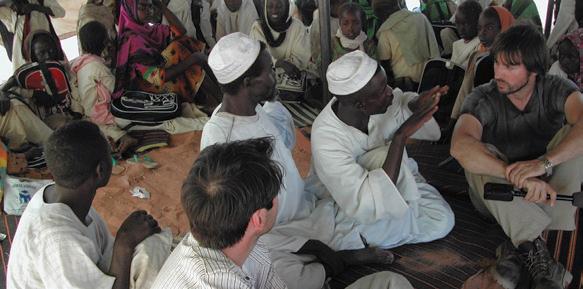
he witnessed the tireless efforts of non-governmental organizations in war-torn regions. These experiences left an indelible mark on Maida’s creative process, inspiring songs like “Al Genina (Leave the Light On)” and “Wipe That Smile Off Your Face,” which carry powerful messages of empathy, political action, and a call for change.
In 2007, he founded War Child’s Busking For Change initiative to raise funds for a school in the Democratic Republic of Congo. The initiative quickly gained momentum and evolved into an annual fundraiser held in Toronto, Montréal, Vancouver, and Calgary.
Maida also produced the War Child benefit album “Help!: A Day in the Life,” showcasing the power of collaboration between musicians to support the cause.
“War Child has provided me
with a global view I may have never had if it were not for the opportunity to travel to counties like Iraq and Sudan,” shared Maida. “Witnessing firsthand the tireless work that War Child does in these war-torn regions is humbling. It gets in your soul.”
War Child supports more than 600,000 women, children, and families every year. They provide numeracy and literacy classes to vulnerable women and catch-up education to children who have missed out on years of schooling. They work with women and youth, offering skills training and small business loans so that they become less aid dependent, lift their families out of poverty, and protect the rights of women and children through access to justice programs.
It’s a long-term holistic approach
that seeks to end cycles of violence and poverty and sets up women and children to look forward to brighter futures. What makes it possible is that 99 per cent of War Child’s staff are locals to the communities the organization works with, allowing them to build systems of change and empowerment not just for these communities but within them.
In 2007, Kreviazuk’s travels extended to Ethiopia, where she visited War Child Canada’s humanitarian programs and raised awareness about the African AIDS crisis and the challenges faced by children who had lost both parents to HIV/AIDS. While there, she met with children, some as young as 12, who, upon their parent’s death, were left to provide for and raise their younger siblings.
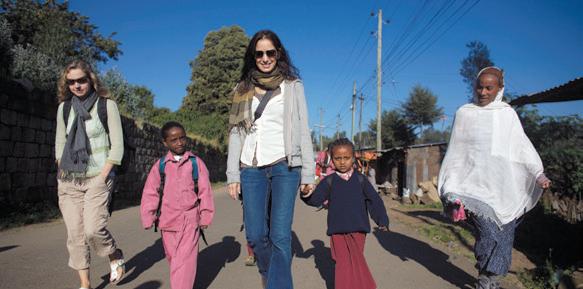
“The eldest siblings are in
charge of the entire family once the parents are gone,” she shared.
Kreviazuk explained that witnessing the transformative power of War Child’s programs, which emphasize education, skill-building, and self-reliance, reinforced her belief in the potential for individuals to rise above their circumstances.
“One of the key pieces to War Child and to these incredible and deserving grassroots charities is that when they start something, they take the time to finish it instead of moving on when the next big thing comes up. It takes a lot of bravery to start a project and see it through,” she said.
Chantal and Raine are frequent performers at War Child’s most important fundraiser of the year, their annual gala—The World That’s Possible, which takes place on December 6th in Toronto this year.

Growing and Strengthening Canada's Urban Forests
Amid the hustle and bustle of urban life, it's easy to overlook the quiet heroes standing tall among the skyscrapers. But these heroes, with their leafy canopies and mighty roots, hold the key to a greener, healthier future. With four out of five people calling urban areas home, nurturing and fortifying
thousands of Canadians join Tree Canada to plant and care for trees at community planting events in every province.

Mark your calendars: this year's National Tree Day will be celebrated on Wednesday, September 20th. Thanks to the generous support of BMO, Tree
cleaning up greenspaces, organizers can register their events on the Tree Canada website for a chance to win a free tree-planting activity in their community.

Since 1992, Tree Canada has worked relentlessly to grow Canada’s tree canopy through our greening programs, research,

©
PEXELS/ANDREA PIACQUADIO
CONTINUED DR. ERIC HOSKINS, DR. SAMANTHA NUTT, CHANTAL KREVIAZUK, RAINE MAIDA © KENNEDY POLLARD DR. SAMANTHA NUTT AND CHANTAL KREVIAZUK IN ETHIOPIA, 2007 © COURTESY OF WAR CHILD RAINE MAIDA IN DARFUR, 2004 © COURTESY OF WAR CHILD Plant Trees in Your Community on National Tree Day Volunteer with Tree Canada to green your community or help organize a National Tree Day celebration! September 20 TreeCanada.ca The power of positive, solution-based journalism. globalheroes.com ADVERTORIAL ADVERTORIAL September • 2023











JOIN US FOR LUNCH AND A TOUR AND DISCOVER THE DELMANOR DIFFERENCE. Book your tour today! DELMANOR.COM AURORA 905-503-9505 ETOBICOKE 416-233-0725 DON MILLS 416-331-9797 NORTH YORK 416-225-9146 RICHMOND HILL 905-770-7963 OAKVILLE 905-469-3232 September • 2023 globalheroes.com
Help us grow healthy kids for a greener future.

Unlocking
the Transformative
Step into the vibrant gardens of Green Thumbs Growing Kids (GTGK), where the magic of school-community gardening is transforming the lives of children in downtown east Toronto. In our quest to cultivate a greener future, we've established a model for garden-based learning featuring high adult-to-child ratios, curriculum-linked programs for all grade levels, and diverse opportunities for children and youth to connect with nature in a meaningful way.
Since our establishment in 1999, the transformative power of gardening with children has been the driving force behind our organization. From September to June, we seamlessly integrate gardening into the academic curriculum. And thanks to a strong partnership with our school board, we've expanded beyond a single school. Every school community is different, and every garden is different. Thus, we all learn and grow together—because in our gardens, nature is the ultimate teacher.
Seventy per cent of the families in our partner schools are racialized newcomers living on low
Power of School-Community Gardens

knowledge on how gardens can mitigate climate change—deeper soil, containing more organic matter, draws down and retains carbon from the atmosphere. By teaching kids how to nurture the soil, we equip the next generation with the tools to care for our planet.


As we embark on this journey, we seek to honour the spirit of the treaties of this land. We acknowledge Tkaronto as a shared territory among the Anishinaabe, Huron-Wendat, and Haudenosaunee peoples.
a post-COVID world. During the summer, GTGK continues to serve our community by engaging in recreational programs, donating surplus produce to community organizations, and tabling at local farmers' markets and community events. We even offer summer jobs for youth, allowing them to reap the benefits of time spent outdoors while gaining valuable experience running programs for all ages.
incomes. As fresh food becomes increasingly costly, school gardens have emerged as a beacon of hope, and food literacy—growing, cooking—is essential for fostering healthy eating habits. Research has shown that children who engage in gardening are more likely to try new fruits and vegetables* and that cultivating a taste for these nutritious
foods will last into adulthood. The delicious fresh foods grown outside their classroom door empower children in new ways. But our mission extends beyond nutrition. Climate health is inherently tied to human health, and we don't shy away from discussing this pressing issue in a way that children understand. Through GTGK programs, children gain valuable
And, through our Indigenous program leaders, we guide students to embrace the wisdom of the Dish with One Spoon Wampum: if we take only what we need, there will be enough for everyone. Our Indigenous staff bring the wisdom of their elders and their names for the plants, helping to bring the Land Acknowledgement, now recited in school, to life.
The benefits of engaging with nature and nurturing plants are scientifically proven to be deeply impactful for mental well-being. The call for outdoor learning resonates louder than ever in
As we urge the Canadian government to follow the lead of other G7 nations in developing a national school feeding program, our curriculum-linked programs empower children and their communities to practice urban agriculture. By supporting GTGK, you contribute your energy to a cause that transcends the boundaries of a single garden. Join us as we foster a greener, healthier and more delicious future for all.
Pain No More: A Mother’s Quest to Reclaim Her Daughter’s Childhood
Any parent can relate to the feeling of anguish seeing their child in pain, especially when that pain results in them missing out on opportunities and activities that bring them joy.
For Heather Talbot and her daughter, Lily, this experience was dotted with missed activities, trips to amusement parks cut short, and passing up opportunities because Lily’s pain was too much for her to bear. But instead of chalking it up to growing pains, Heather decided to look closer and find out what was really holding her daughter back.
“Lily’s pain persisted for so long and didn’t seem to come and go,” said Heather. “She was in pain almost constantly, which isn’t in line with what I know about growing pains. Her pain would get so bad with any activity she did; it seemed there must be something more going on.”
Lily suffered from joint pain in her back, hips, knees, ankles, and feet, steadily persisting for years. It was a constant companion, haunting
her every move. For Heather, the culminating moment was when Lily came home in tears, sharing that she had made the school’s volleyball team but could not accept the spot—the pain she felt from just the tryouts was unbearable.
When Heather heard about the Paediatric Chronic Pain Program at Children’s Hospital at London Health Sciences Centre—she knew it was just what she and her daughter were looking for.
“It took a few months, but once we had our initial assessment, Lily started medication and physiotherapy, psychotherapy, and got orthotics,” Heather shared. “This all combined to be a huge help to her. Lily continues to be followed by the care team and also continues with regular treatments to maintain being (mostly) pain-free!”
Pain is typically considered chronic if it persists for over three months, stemming from injuries that should have healed, unknown physical reasons, or recurring episodes
caused by specific illnesses. As the causes can be layered, so too are the treatments: treating chronic pain requires a combination of physical, psychological, and pharmacological medications working together.
Established in 2015, the Paediatric Chronic Pain Program at Children’s Hospital provides assessment, treatment, and consultation for children and adolescents experiencing chronic pain that interferes with school, physical activities, family, and social functioning.
“One in five youth in Ontario suffer from chronic pain, however, there are only four programs like this in the province. What makes our program different is the inter-disciplinary approach and the way we focus on care not just for the child, but for their family and environment,” explained pain nurse Susan Carter, co-lead of the Pediatric Pain Program. “It can be challenging for the caregivers and community to support a child through something you might not understand.
We have group therapy for the patient as well as caregivers to help children do more of what they love.”
Now 13 years old, Lily’s life is filled with the things she loves to do, like dancing and musical theatre, with nothing holding her back. Having Lily’s pain validated and treated has been transformative for her and her family.

“I am much better,” Lily shared. “I don’t have to constantly think about my pain, I can just enjoy life and do all the things my friends do.”
Looking back on her journey, Lily said that if she could tell her past self one thing, it would be that it gets better.
“Some days I felt so hopeless, like I couldn’t keep up with my friends or enjoy the things other kids were able to do,” she said. “This year, I was cast in almost every dance at the theatre company I perform with, jumping off blocks and completing complicated choreography. I could never have done that without the help of the Chronic Pain Program.”
Growing Green Leaders: EcoSchools Canada Inspires Students to Take Action
When a group of Grade 6 students at James Morden PS learned about the environmental impact of air travel, they decided to get creative to raise awareness and create change. Inspired by EcoSchools Canada’s program that rewards environmental learning and action, the students redesigned their local airport in Niagara using the popular video game Minecraft, integrating sustainable elements such as solar panels and compost systems. This greener transformation was shared with the airport in hopes of a real-life change.

This school was among 5,000 schools nationwide that have participated in the EcoSchools Canada program, and this project helped propel them to a Platinum certification, the highest level a school can earn. Schools across the country leverage the program’s gamified platform and framework centred around action and measurable results in school communities. In 2023, almost 30,000 K-12 students joined their school’s EcoTeam (environmental club) and helped to divert over 475 tons of waste and plant more
than 500 pollinator gardens at their schools.
Registering for the EcoSchools program is free for publicly funded schools in Canada, and once signed up, students and teachers can collectively select from over 50 different actions to complete over the course of the school year. Actions include a guidebook, tracking sheets, and a series of questions designed to measure impacts so students can see their progress over time. All activities include both a learning and action component, and teachers are encouraged to get students outside to learn in, about, for, and from the environment. Schools earn points for completing each action and receive a certification ranging from Bronze to Platinum for their efforts at the end of each school year.
One of the strengths of this bilingual program is its national and global network, spanning over 70 countries. New this year, schools can apply for a mentorship program, where new schools can learn from experienced schools while forming relationships with other passionate young environmentalists. This collaborative
approach nurtures a sense of community and shared responsibility for the environment. Through the international network, schools can also gain access to a wealth of knowledge and best practices in sustainability while participating in inspiring global campaigns.
Participation in the EcoSchools program has shown
measurable benefits, including reducing GHGs and increasing student and teacher engagement with environmental issues and the UN SDGs. By providing educators with tailored resources, the program acts as a one-stop shop for teachers to easily incorporate environmental education into the classroom.
“EcoSchools has provided our school with a flexible, personalized framework for advancing environmental initiatives in our school community. Broader exposure and participation this year has us excited about the possibilities for next year! Thank you to EcoSchools for giving us the opportunity to learn and grow as a school community, we definitely wouldn’t have been able to achieve what we did this year without your support and guidance.”
—Amy Cook, Teacher, Fundy Middle and High School, St. George, New Brunswick
In addition to the recognition that comes with being an EcoSchool, there are exciting opportunities throughout the school year, including the chance to win a variety of prizes, design and deliver awareness campaigns and engage their communities in environmental actions. With registration for the 2023-24 year now open, EcoSchools Canada invites educators, students, and parents to join the movement and make a meaningful impact.
Learn more and get involved at ecoschools.ca

* Langellotto, G.A. & Gupta, A. (2012) Gardening Increases Vegetable Consumption in Schoolaged Children: A Meta-analytical Synthesis. HortTechnology 22(4). Learn more at greenthumbsto.org
WINCHESTER 2018 © COURTESY OF GREEN THUMBS TORONTO
greenthumbsto.org
© COURTESY OF ECOSCHOOLS CANADA
LILY PERFORMING © ROSS DAVIDSON The power of positive, solution-based journalism. globalheroes.com ADVERTORIAL ADVERTORIAL September • 2023
Mental Health Heroes at Work: Empowering Recovery at Ontario Shores

The need for mental health care is at an all-time high. Studies have shown that one in five people in Canada will personally experience a mental health problem or illness every year. Mental health conditions affect millions of individuals worldwide, transcending age, education, income level, and cultural background.
Despite its prevalence, mental illness continues to carry a burden of stigma, hindering access to necessary support and treatment. Ontario Shores Centre for Mental Health Sciences (Ontario Shores) shines in the face of these challenges, providing revolutionary care and fostering transformative recoveries. By championing change and advocating for mental health, Ontario Shores and its dedicated Mental Health Heroes make recovery possible for individuals and families with complex mental health challenges.
Psychological disorders, commonly known as mental health disorders, are caused by a complex interplay of genetic, biological, personality, and environmental factors. It is reported that almost one-half (49 per cent) of those who feel they have struggled with depression or anxiety have never gone to see a doctor about this problem.
At Ontario Shores, the focus is on personalized recovery plans encompassing a range of treatment options. Every aspect of care is tailored to the individual’s needs, from medication to cognitive-behavioural therapy (CBT), psychiatric and psychological therapy, group therapy, and peer support counselling. Recognizing the importance of holistic well-being, Ontario Shores also emphasizes the role of diet, exercise, good sleeping

because we not only offer numerous outpatient programs, but we also manage patients with hardto-treat mental illnesses through specialty treatments provided by a skilled and caring multidisciplinary team,” explained Dr. Kevin Chopra, Medical Director of General Psychiatry at Ontario Shores.
“Time is essential when treating people with severe mental illness. It takes time for medications and other therapy approaches to work, particularly when treating people struggling with severe illness. By coming to Ontario Shores, people can access the time, flexibility, and individualized care they need to recover.”
For over a century, Ontario Shores has provided compassionate, exemplary mental health care in a healing, recovery-oriented
“My sister had been tormented by mental illness for over three decades and, over the years, my family had given up hope and a future. Thanks to the utmost care of Dr. Chopra and his team at Ontario Shores for the last two years, we have witnessed and experienced a rebirth in my sister’s life! Seeing that my sister can now enjoy life and be able to take care of herself is the biggest blessing for our family and we will forever be indebted to Dr. Chopra and Ontario Shores!” —Mona Wong and family donated in support of the Complex General Psychiatry unit at Ontario Shores in honour of their sister, and Dr. Chopra and his team.
the care they received—those are the reasons why we went into medicine.”
Ontario Shores’ impact extends far beyond its hospital walls. The institution is renowned locally, nationally, and internationally for its leadership in mental health. Through cutting-edge research, Ontario Shores is pioneering advancements in mental health care that transcend traditional boundaries.
“At Ontario Shores, we have many community partnerships that support patients receiving the appropriate level of care in the right setting. For example, a person transitioning to outpatient care will work closely with our community teams to ensure they have the environmental supports they need for a successful transition,” Dr. Chopra continued.
shared. “It is essential to have a system that patients, families, and health care providers can easily access to find the right help at the right time. That is why donor support is so important. Funds raised through the Ontario Shores Foundation can help to improve that access and reduce wait times.”
The generosity of donors goes a long way at the Ontario Shores Foundation, paving the way for exemplary mental health care and stronger support throughout the recovery process. Their work creates a sense of hope for both the individual patient as well as the grateful family who surrounds them. The Ontario Shores Foundation's grateful patient program, aptly named Mental Health Heroes, provides patients, families, and caregivers a way to express gratitude for the transformative mental health care they received.
This program allows patients and families to donate in honour and recognition of an Ontario Shores physician, therapist, nurse, caregiver, or staff member who made a difference in their life.
When you support the Mental Health Heroes program with a donation, not only are you showing your appreciation for the revolutionary care you or a loved one has received, you are helping ensure others living with complex mental health challenges can access the hope and recovery they need at Ontario Shores too.
To contribute to the life-saving care provided at Ontario Shores, consider donating today. You will help ensure that individuals and families receive the compassionate care they need to embark on a journey of recovery. Join the movement
THE GENERAL PSYCHIATRY TEAM © COURTESY OF ONTARIO SHORES CENTRE FOR MENTAL HEALTH SCIENCES DONATE TODAY OntarioShores.ca/Donate
DR.
KEVIN CHOPRA AND
globalheroes.com ADVERTORIAL September • 2023
The Need for Mental Health Care is Greater Than Ever. Recovery is possible. It happens at Ontario Shores.
The Chronic Pain Network: Revolutionizing Pain Management in Canada
Chronic pain is one of the most common conditions affecting Canadians—an estimated one in five children, adults, and seniors experience pain that affects their ability to participate in daily activities, including work, leisure, and the simple activities of daily living. Pain is a complex condition in which biological issues (arising from trauma, disease, following surgery or after treatments for other conditions, such as cancer) interact with psychology (how people learn and understand their health, their underlying mood disorders, past histories of illness, trauma, and abuse) and their social setting, including the social determinants of health.
In 2016, the Canadian Institutes of Health Research (CIHR) funded the Chronic Pain Network (CPN) under their Strategy for PatientOriented Research (SPOR) program. The SPOR program recognized that viable solutions require the active engagement of People With Lived Experience (PWLE) to ensure that research focuses on those areas most valuable to the patients themselves. These patient partners also participate in the

conduct and promotion of the research and ensure respectful and effective conduct throughout.
BREAKING THE CHAINS OF CHRONIC PAIN
Now in its seventh year of operation, CPN has engaged researchers, healthcare professionals, educators, policymakers and patient partners nationwide to change how we manage pain in Canada. Patients have established priorities for pain research in adults and children and are an integral part of the governance of the CPN—a patient partner co-chairs every governance committee. The Network, based at McMaster University, has created new knowledge across the country and the lifespan. Examples include the impact of parental pain on children’s experience of pain, awareness of the interactions between mental health disorders and chronic pain, understanding of the problem of undiagnosed pain in elderly living in institutions and the cost of not treating this pain, the benefit of smartphone apps to not only gather research data but help adolescents manage
their pain, and increased understanding of the chronic pain problems that arise in Indigenous children, their challenges in communicating their pain experience and their difficulties accessing culturally appropriate care. New relationships have been built among Indigenous health researchers across the country, between basic and clinical scientists studying pain, and a national network of academic pain clinics participating in clinical trials has been created. Our patient partners were available
to advise Health Canada on its opioid strategy and the importance of recognizing the needs of people living with pain, and several also became members of the federal Canadian Pain Task Force, established by the Hon. Ginette Petitpas Taylor.
FROM RESEARCH
TO ACTION
Patient partner Linda Wilhelm said, “It’s helped me to take my experience of living with chronic pain to help improve the lives of other people, so they don’t go
through what I’ve gone through,” about her work with CPN. For the next four years, the CPN will focus on moving knowledge into practice—creating an infrastructure to enhance public awareness of the problems of chronic pain, improve the education of healthcare professionals, provide education for pain researchers in the concepts and practice of patient engagement in their work, advise those providing pain care, researchers, and public policymakers. There will also be a significant focus on the sustainability of the network activity.
Fundraising will address the need to support the network infrastructure and advocacy directed toward allocating health and social science research dollars to better understand pain, its treatment and the social determinants of health that place people at risk and hinder their access to treatment.
“Together we can make meaningful change for many years to come for people living with pain,” said Carolyn Bennett, Canada’s Associate Minister of Health. Find the Network online at cpn-rdc.ca
Communities Unite Against Canada’s Wildfires: Resilience and Support Shine Amidst the Flames
particular, are they so bad?
ALLIE MURRAY
This summer in Canada was a season like no other—one that was plagued by wildfires, smoke, air quality warnings, and destruction across the country. While Canada is no stranger to a fiery summer, 2023 marked the most destructive wildfire season on record.
Canada is home to nearly nine per cent of the world’s forests, making it easy for wildfires to quickly become out of control. Online, The Canadian Interagency Forest Fire Centre provided a live map with frequent updates showcasing how many active fires were happening across the country, where they were, how many were out of control, and so on. At the time of writing, the interagency recorded some 5,000 wildfires since the beginning of 2023, scorching more than 13.4 million hectares of land and evacuating thousands from their homes.
The main question Canadians are asking is how do wildfires start? And why, this year in

This question is not answered very easily, according to Magda Zachara, Program Manager with FireSmart Canada.
“Approximately 50 per cent of wildfires are human caused in Canada,” she explained. “The public should educate themselves on what they can do to limit those human-caused fires—like ensuring they know how to properly extinguish camp fires, how recreational vehicles can cause sparks, how fireworks can contribute to fires, and so on.”
Similarly, the Government of Canada noted that lightning strikes are also a major cause of wildfires in the country, accounting for nearly 67 per cent of the land area burned.

This year's fires started earlier than ever before—fires typically rage from May to October; however, due to early heat, low precipitation and dry conditions, the fires became out of control earlier. By mid-June of this year, Canada had already surpassed the record for area burned by wildfires in a single year.
As the fires continued out of control, firefighters in Canada struggled to keep up with the blazes that raged in the west, east, and central parts of the country.
According to a survey conducted by Reuters of all 13 provinces and territories, Canada employs around 5,500 wildland firefighters, not including Yukon territory, which did not respond to requests. That is roughly 2,500 firefighters short of what is needed, according to Mike Flannigan, a professor at Thompson Rivers University in British Columbia and wildfire specialist.
To support the need for manpower, 700 firefighters arrived in Canada from South Africa, Australia, New Zealand, the United States, France, Costa Rica, and more to help with the blazes.
The South African firefighters came with the help of the Department of Forestry, Fisheries and the Environment’s Working on Fire programme. The country sent a contingent of 200 firefighters to Alberta, this year being the fifth time that South
African firefighters have come to Canada to assist with wildfires.
“We are proud of the fact that South Africa is again able to assist Canadian firefighting teams in their battle to bring the wildfires under control,” said Minister Barbara Creecy. “The extensive experience and training of these firefighters will significantly enhance efforts to effectively suppress and manage the wildfires in Alberta.”
Going forward, Zachara notes that while we cannot eliminate fire from the landscape, there are ways we can be better prepared
for future wildfires.
“Over time, we’re seeing a rise in the occurrence and severity of wildland fire, so it is important for citizens and communities to take proactive measures that help reduce risk to their homes and properties against the risk of wildland fire,” she explained.
She explained that residents can minimize available fuel to feed the fire and ignite structures by using non-combustible materials on their homes and removing any combustible materials within the first 1.5 metres of the home.
Caring at Your Convenience: WFYO's App Paves the Way for Accessible Youth Counselling in Ontario
Technology is ever-present in our lives—palm-sized digital worlds occupy our pockets and provide access to almost anything we can think of. It only makes sense to leverage the power of technology for the betterment of our mental health. That's why, in honour of its 10th anniversary, Wellness & Emotional Support for Youth
Online (WFYO) is proud to unveil an innovative e-counselling platform and a brand-new mobile app specifically designed to make mental health support more accessible and convenient for youth across Ontario.

WFYO understands that young people face overwhelming stress and anxiety from various sources, such as school, relationships, and family dynamics. During these difficult transitional periods, having the proper support can be the key to finding success and building a solid foundation for better mental health. With the new e-counselling app, young people will have the ability to access professional mental health support anytime,
anywhere, right at their fingertips. This has long been the mission for WFYO; since their inception in 2012, WFYO has provided counselling to over 3,000 youth aged 13-24 in Ontario. In June of 2022, WFYO celebrated 10 years of service, a milestone event that looked back on how much help and support the organization has been able to provide for young people across the province.
In celebration of their enduring support for Ontario's youth, WFYO has completely revamped their virtual services, redefining how young people can connect with our counsellors. Through the asynchronous email-to-email option, live chat function, and video calls, teens and young adults can access WFYO's services from the comfort of their chosen space.
But that's not all. WFYO believes in the power of creative expression as a means of self-discovery and healing. That's why they've introduced a new feature to the platform: the Gallery

submission function. Now, teens and young adults have the opportunity to share their meaningful media, photos, and artwork with their counsellors, fostering deeper engagement and connection in the therapeutic process.


Accessibility and inclusivity are at the core of WFYO's mission. They strive to break down barriers and ensure that every youth in Ontario can receive safe and secure mental health care. The organization's decade of service has shown that the concerns of young people require time, trust, and ongoing support. That's why WFYO offers continuous counselling, allowing youth to develop a trusting relationship with their counsellors as they navigate the complexities of mental health.
It is often during difficult transitional periods that we need the most support, and no one can guess when that support will be most beneficial. By embracing new avenues of communication, we are forging a path toward better mental health together.
But WFYO can't do it alone. Providing evidence-based care and reducing waitlists and wait times for youth mental health support across Ontario requires support from the communities it serves—communities like yours. Your donations will make a tangible difference in the lives of young people, removing barriers and ensuring they receive the care they deserve.
Join WFYO in their mission to meet young people where they are and provide the support they want, when they want it, and how they want it. Together, let's build a brighter future for youth mental health in Ontario.
Let's make mental health a priority for our youth, because their well-being matters.
To learn more about WFYO's services, download the app or visit wesforyouthonline.ca
PATIENT PARTNERS MEETING TO DISCUSS FUTURE PLANS OF THE CPN © COURTESY OF CHRONIC PAIN NETWORK
FOCUS FORWARD TO BETTER YOUTH MENTAL HEALTH WES FOR YOUTH ONLINE DONATE TODAY. BIT.LY/FOCUSFORWARD3
A SOLDIER OF THE 5TH CANADIAN MECHANIZED BRIGADE GROUP VIEWS A WILDFIRE FROM A CANADIAN FORCES HELICOPTER SURVEYING THE AREA NEAR MISTISSINI, QUEBEC, CANADA © REUTERS/ FILE PHOTO © COURTESY OF WES FOR YOUTH ONLINE The power of positive, solution-based journalism. globalheroes.com ADVERTORIAL ADVERTORIAL September • 2023
Empowering Young Minds: The Strong Start Program and the Right to Read
Literacy is the key to success, empowering the imagination and paving the way for bright futures. Literacy allows us to make sense of what we see, hear, and read— so it is disheartening to know that many children still struggle to learn to read.
However, there is hope in the form of the Strong Start program.
Founded in 2001 by philanthropist Lyle S. Hallman and esteemed educator Lynda Silvester and driven by dedicated volunteers, Strong Start is a community initiative that aims to ensure that all children can learn to read.
Strong Start understands that everyone learns differently, and with a focus on early intervention and a proven track record of success, this program is changing the lives of thousands of children.


THE RIGHT TO READ
Learning to read is not just a skill; it is a fundamental human right. The Ontario Human Rights Commission’s Right to Read report emphasizes that without the ability to read, children are at risk of lifelong difficulties. By teaching foundational word-reading skills, such as phonemic awareness and phonics, children are set up for success from an early age.
Reaching children early is critical; the earlier the intervention, the greater the impact. Strong Start has three programs that provide literacy support to children from six months to nine years of age: Baby Connections® (six to 12 months), Get Ready for School™ (ages three to four), and Letters, Sounds and Words™ (ages five to nine).
In the Letters, Sounds and Words
schools, private faith-based schools, and schools for children with exceptional needs. This program helps all children who need a literacy boost, including newcomers and children from low-income backgrounds.

ALL CHILDREN READ Research from the National Strategy for Early Learning found that one in four Canadian children who enter Grade 1 are significantly behind their peers, which results in the tendency to fall further behind as they progress through schooling. The Right to Read report supports this: the window of ages
that allows children to reach their maximum potential.”
—Tim Jackson, Strong Start Supporter from Social Venture Partners Waterloo Region
The COVID-19 pandemic has further highlighted the urgency of Strong Start's mission. In his recent study on the impact of COVID on learning, Professor George Georgiou of the University of Alberta found that young children who were previously struggling with reading have now fallen an additional four to 12 months behind in literacy skills.
“Here’s the challenge: if we don’t
readers throughout their life.”
Strong Start works to help young children learn to read by providing unique programs through community-wide partnerships. Every child deserves the best chance for healthy development and the building blocks for a successful life—and that starts with making sure that all children read.
“The program just became another part of what she did at school, but it contributed so much to what she was able to do from that point on. I saw a change in her and now when I see her with all her books curled up and read
Strong Start program achieve considerable, excellent, or outstanding gains in their literacy skills. These measurable results demonstrate the program's effectiveness in bridging the literacy gap and leveling the playing field for all children, regardless of their backgrounds.
SUPPORTING
BRIGHT FUTURES
Volunteers are the heart and soul of Strong Start. By dedicating just a few hours, they make a lasting impact on a child's life, giving as little as 30 minutes a week for 10 weeks.
“I am watching a shy child come out of their shell and gain confidence as they are learning their letters,” said one volunteer. “This is why I chose to volunteer. It is so rewarding, and I feel like I am making a difference, one child at a time.”
“We have completed a full round of 10 weeks and are amazed with the transformation of the students. The post-assessments have shown us that significant improvements have been made. Teachers are reporting that students are much more confident and willing to take more risks in their literacy activities in the classroom. As a principal and co-coordinator, it was such a pleasure listening in on the interactions and seeing the joy on the children’s faces as they played the games provided.”
—K. Kuiack, Principal.
Empower young minds through the gift of literacy. Donate to Strong Start and help us build a world where every child can read, or become a partner and pave the
54,819 CHILDREN
398 SITES

37,574
628,141 HOURS
VOLUNTEERS
FIND MORE INFORMATION AND GET INVOLVED AT STRONGSTART.CA © IMAGE COURTESY OF STRONG START globalheroes.com ADVERTORIAL September • 2023
Empower young minds through the gift of literacy. Help us build a world where every child can READ! Become a Strong Start partner, volunteer or donor and pave the way for a strong community.
Nature Belongs Here: Accelerating Impact Across Southern Ontario

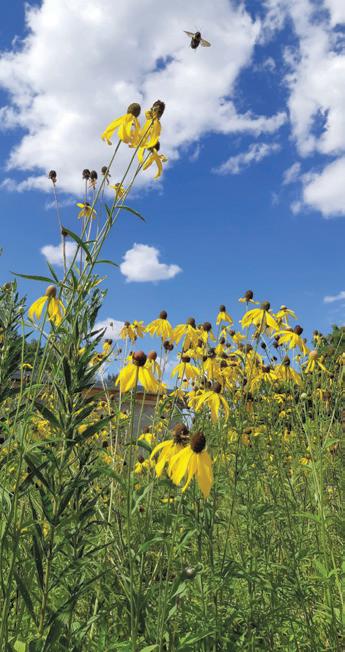
The need to preserve biodiversity and combat climate change has never been more urgent. Ontario’s natural wealth of diverse ecosystems must be protected, and the Carolinian Zone Conservation Impact Bond (CIB) stands out as a groundbreaking solution.
pioneering pay-for-success model that harnesses the power of impact investment, bringing together diverse stakeholders to accelerate the development of healthy and resilient landscapes in southern Ontario. With remarkable success, the CIB has captured the attention of investors worldwide, establishing itself as a cornerstone solution for nature-based conservation.
ON HOME TURF
Stretching from Toronto to Windsor, the Carolinian Zone is home to 25 per cent of the Canadian population, 10 First Nations communities, and over a third of the country's at-risk species. But the region's varied biodiversity is under threat—habitat loss and fragmentation are damaging the zone’s ability to support its ecosystems
To tackle this pressing challenge, the CIB reimagines the conservation finance space, creating a unique opportunity to restore habitat, protect biodiversity, and meet international biodiversity and climate resilience targets.

Collaboration is at the heart
cross-sector leaders, Indigenous communities, academic institutions, and impact finance communities. Together, they create a strong investment portfolio for landscapes, based in ethical space, that supports Indigenous Leadership and reconciliation. This powerful, outcome-based model brings together environmental and sociocultural benefits, reduces risk, speeds up progress, and encourages innovation and effectiveness.
A representative of Kayanase, an Indigenous-owned Native Plant Nursery and Ecological Restoration business in Six Nations of the Grand River Territory, said, “Kayanase chose to participate with the Carolinian Canada Coalition’s Conservation Impact Bond because of their commitment and desire to support our internal capacity building efforts and finding a place within the Native Plant Economy. Along the way, our partnership is actively growing to support our participation in Indigenous leadership in conservation including forestry initiatives and co-developing a Southern Ontario
the Carolinian Life Zone.”
A TESTAMENT
TO SUCCESS
From the beginning, the CIB has achieved significant milestones in promoting healthy landscape projects in the Carolinian Zone.
As of April 2023, it has secured $1.58 million from various sources, including funders, investors, and outcome payers. This funding has led to the improvement and resilience of 269 hectares of land and has successfully engaged over 1,000 individuals across 20 communities. The outstanding accomplishments of the CIB have garnered international recognition, including the esteemed Finance for the Future Climate Leader award in 2022.

“Being a climate leader is creating gifts for future generations. We are all accountable for or affected by the irreparable harm to people and nature through colonial economic systems. This is one small way to start to shift those systems to make positive impacts,” said Michelle Kanter, Executive Director,

diversity and climate crises can be actioned in other regions.”

The Long Point Walsingham Forest Priority Place in southern Ontario is a testament to the effectiveness of the CIB. This region, characterized by its rich biodiversity, species at risk, and engaged communities and conservation organizations, was chosen as a focal point for the CIB's expansion. With its proven success and transformative impact, the CIB is poised to engage new partners for future projects and further accelerate its reach across southern Ontario. By continuing to mobilize private and public investment, the CIB will drive restoration efforts, protect biodiversity, and foster resilience within the Carolinian Zone. Through collaboration, innovation, and a steadfast commitment to ethical space, the CIB is providing a process that honours a commitment to healing the land. Nature belongs here, after all.
A greener future is within reach. Visit caroliniancanada.ca/cib/ globalheroes to learn more.



Merging Pain With Purpose: A Teen’s Triumph Over Arthritis
Vancouver teen Maddie Watts craves the exhilaration of flying downhill, carving through the snow with the wind in her face. At 16, Maddie feared arthritis had stolen her favourite sport. But today, Maddie is using her incurable disease to aspire to greater heights, experiencing the slopes in a new way with a new pursuit—the 2026 Winter Paralympics in Italy.
When Maddie’s dad encouraged her to try adaptive skiing, she never imagined catching the attention of the Canadian Paralympic Committee with her natural talent. On her third day of sit skiing, an email arrived with an unexpected invitation to train.

“Being any kind of Olympian was never something I thought I would do or even want to do,” said Maddie. “But when the opportunity arises, you’ve at least got to try!”
A whole new world of opportunity and promise has opened for Maddie.
But the promising opportunity came at the cost of an uphill battle with an abrupt life pivot— severe arthritis.
One day, Maddie went from
being a seemingly healthy teen passionate about skiing to collapsing and lying in a hospital bed. This started an agonizing 18-month journey to a diagnosis of joint facet syndrome, an acute form of arthritis aggressively attacking her spine.
No one thinks of arthritis in youth. It’s one reason why it took so long to get a diagnosis. The agony of uncertainty and debilitating pain was nearly unbearable.
“I had been misdiagnosed a
few times because my condition is not recognized in young people,” shared Maddie. “Receiving my diagnosis was, more than anything, a relief. I had spent so many months entirely lost on what was happening to my body, why it was happening, and how to help myself thrive again.”
Arthritis stole precious moments of Maddie’s teen years, causing her to miss school, prom, and activities with her friends. She had days of sitting in a wheelchair or using
a walker while her friends were out skiing and dancing. She lost relationships because she couldn’t be present in the same way. When Maddie’s doctor said she couldn’t ski again, the words struck like a final crushing blow, snatching away hope. She had lost so much all at once. But everything changed the day Maddie first sat in the moulded bucket seat above the skis, clasping the outriggers, and once again felt the snow passing beneath her. With her family’s unwavering support, she relearned her sport in a new way. Maddie found herself dreaming again—ready to fight for her future.
While reinvigorated with new aspirations, arthritis remains Maddie’s constant companion. She endures pain, exhaustion, medical trials, adverse reactions, unpredictable flare-ups and the isolating frustration of living with an invisible disease.
Maddie has found support through Arthritis Society Canada’s peer groups and helpful resources. She’s also discovered the shared challenges in the difficult diagnosis process among
young people and is motivated to do something about it.
Merging pain with purpose, Maddie advocates for arthritis awareness, especially among youth, while passionately pursuing the 2026 Paralympics.
“It’s such a misunderstood disease and often dismissed as a natural part of aging,” shared Maddie. “But one in five Canadians, and as many as 25,000 Canadian children, live with arthritis. It’s a serious disease and there is no cure.”
Despite her chronic condition, Maddie sees herself beyond arthritis, aiming to inspire and bring hope to others facing similar challenges through arthritis advocacy and her Paralympics pursuit. "Through it all, it's important to leave yourself time to live," said Maddie.
In her sit ski, experiencing the rush of racing down beautiful snow-covered mountains, Maddie is living. With the tenacity of a hopeful Olympic athlete with promise, she’s determined to turn her pain into purpose and make a difference in the lives of others.
Get recognized with the world’s highest achievement in management & leadership
CHARTERED MANAGER As a Chartered Manager you’ll join a community of high performing professional managers at the top of their game who are self-aware and skills-focused, delivering real value for their business. You can obtain your Chartered Manager designation after 48 months of professional level management experience along with a degree. Do you strive for excellence and want to be professionally recognized? Visit us today at cim.ca to start your journey!
www.cim.ca/cmgr
CAROLINIANCANADA.CA
INVESTING IN NATURE, TOGETHER
PHOTO: VICKI HAMMOND
© JENNIFER NANTAIS
MADDIE WATTS ADAPTIVE SKIING © COURTESY OF MADDIE WATTS The power of positive, solution-based journalism. globalheroes.com ADVERTORIAL September • 2023
It’s Not Just Arthritis: Unveiling the Hidden Burden of Arthritis
For someone with a chronic disease like arthritis, pain is a familiar companion. Simple everyday tasks like getting dressed, walking, or cooking become daunting, diminishing one’s sense of control over their body and well-being.
Arthritis is a chronic and persistently painful disease that impacts people of every age, gender, and ethnic background. There are more than 100 types of arthritis, and there is no cure.
“Arthritis is so much more than just a mild, aching joint. It’s a brutal disease that robs millions of people of their mobility, independence, livelihood, mental and physical health, and overall quality of life,” said Arthritis Society Canada President Trish Barbato. “It has a staggering impact.”
CANADA’S
MOST COMMON CHRONIC DISEASE
More than one in five Canadians live with arthritis, making it the nation’s most common chronic disease. It’s not “just arthritis” or a “two Tylenol” condition, but an urgent health concern projected to reach over nine million Canadians by 2040.
“Arthritis is a devastating chronic condition, and six million Canadians are aching for a cure. The time to transform how we understand, prevent and treat this disease is now,” said Dr. Siân Bevan, Chief Science Officer of Arthritis Society Canada.
Arthritis research is underfunded relative to its burden and prevalence, said Ms. Barbato. More Canadians report living with arthritis than diabetes, heart disease, cancer and stroke combined, yet it remains one of the most under-funded, under-recognized and under-represented diseases. It is a leading cause of disability and work limitations in Canada, yet many still don’t understand how serious it is.
As Canada’s largest charitable funder of arthritis research, Arthritis Society Canada has invested over $230 million since


its inception and doubled its annual investment in research since 2020. The organization is urging our government and community to do more.
A MOTHER AND CHILD’S ARTHRITIS JOURNEY

Imagine watching your toddler shuffle slowly in pain instead of running and climbing. This was the reality Keiko Kataoka faced as a mom when her two-yearold daughter was diagnosed with childhood arthritis.
“It was really challenging because we knew something wasn’t as it should be, but we had to rely on observation as she couldn’t communicate her pain with us. I didn’t know that arthritis could impact children, so it didn’t initially cross my mind as the cause,” Keiko said.
Just two years later, shortly after the birth of her second child, Keiko could not lift her child out of her crib because arthritis flareups caused weakness and debilitating pain. Along with facing the challenges of being a mother of a child with a chronic disease, Keiko now had to learn how to manage and treat her own pain.
“Because of our experience, I reached out to Arthritis Society Canada for resources and support,” shared Keiko. “It has made such a difference to find a community of people who really understand what it’s like to live with arthritis and it helps us feel less alone in this journey.”
Children and youth suffering from arthritis often feel isolated and alone in their challenges, and there is a great need for connection, support, education and awareness of childhood arthritis. Over the last five years, with the support of our donors, Arthritis Society Canada has invested $4.2 million specifically in childhood arthritis research.
Arthritis Society Canada recognizes the physical, emotional and mental toll of childhood arthritis and is responding by increasing investment in programs for
children and families impacted by arthritis. Adapted summer camps, backpacks for recently diagnosed children, virtual support clubs and new resources for young adults empower kids and their families to manage their pain and symptoms so they can live their best lives.
MANAGING
CHRONIC PAIN
Recognizing the complexity of pain is vital for effective management. Chronic pain is challenging to manage because what works for one person may not necessarily work for another. Chronic or persistent pain may require a combination of strategies. Medications are only one part of an overall strategy to help reduce an individual's pain so that they can better cope physically and emotionally and have improved function and ability to do everyday activities. It is helpful to use pain
management techniques that are active coping strategies, including advocating for yourself in the health system, eating well, staying active, managing stress, participating in relaxation exercises like mindfulness meditation, and seeking social support. Family and friends can offer emotional and physical support and stay informed about your health condition and what works best for you.

This multi-pronged strategy for pain management is proactive and realistic, and helps a person reclaim agency and control over their life. While there is no cure, Arthritis Society Canada is investing in innovation and research to find solutions—and to help people adapt to living with a chronic disease.

Individuals impacted by arthritis can find community, support and the latest evidence-based research through Arthritis Society Canada at arthritis.ca
Youth with sports-related knee injuries are more likely to develop knee osteoarthritis (OA). As young athletes look ahead to the future, the following evidence-based recommendations can help prevent the early onset of knee osteoarthritis.
WHAT CAN YOU DO TO HELP PREVENT KNEE OSTEOARTHRITIS AFTER AN INJURY?
Consult with your doctor to avoid further injury. Educate yourself on the risk of knee osteoarthritis and clinical recommendations for prevention after a knee injury to help prevent osteoarthritis.
Eliminate thigh muscle weakness. Limit saturated and trans fats and keep fat levels within a healthy range. Meet weekly physical activity guidelines.
Arthritis Society Canada funds cutting-edge arthritis research across Canada. Research into the factors influencing the quality of life of young people with a history of knee injury will help inform knee injury management, rehabilitation, and osteoarthritis prevention strategies. In 202223, Dr. Jackie Whittaker’s research and leadership of the OPTIKNEE international consensus group led to eight clinical recommendations on who to target to prevent osteoarthritis after a knee injury, what to do and when. These new recommendations will improve knee rehabilitation programs.
Everything my arthritis touches, it sears. It stole my ability to ski. It forced me to miss prom. At one point, it put me in a wheelchair.
THIS is arthritis.
globalheroes.com ADVERTORIAL September • 2023
KEIKO AND AYA KATAOKA © COURTESY OF ARTHRITIS SOCIETY CANADA
September • 2023
Breaking Barriers and Empowering Futures for Students


Education is the gateway to a world of dreams, and with the Toronto Education Workers/Local 4400 Members on the job, those dreams can come to fruition.
Toronto Education Workers/ Local 4400 was formed to improve the social and economic welfare of its Members, and in compliance with the Human Rights Code, race or creed, sexual orientation, without regard to gender, to promote efficiency in public employment and to manifest its belief in the value of the unity of organized labour.
Toronto Education Workers/ Local 4400 represents the Education Workers who work within the Toronto District School Board (TDSB), Bloorview School Authority, Childcare Workers from Not Your Average Daycare (NYAD), Maurice Cody, McMurrich Sprouts and Childspace, Caretakers from the Toronto Catholic District School Board (TCDSB), Viamonde French Board and Jewish Immigrant Aid Services (JIAS).
Representing over 400 Job Classifications in over 1,000 Worksites,


our Members are entrusted with the safety, responsibility, and assistance of delivering quality education to the students and adult learners attending all the schools and or worksites. Their unwavering commitment to the students they serve and the relentless compassion and dedication they embody are visible in every task they undertake.
We would like to thank all those who cared for the students over the summer, all the parents, grandparents, families and guardians during the rain and the heat! As the new school year begins and we return to our routines, students and Education Workers alike embark on journeys of excitement, stress, and anxiety. Students face the prospect of starting
at new schools, meeting different teachers and peers, managing new classwork, and navigating unfamiliar routes. Education Workers deal with many of the same challenges, coupled with the constant changes within the education system due to staffing and funding cuts, resulting in fewer resources and specialized programs for vulnerable students who are already
at a disadvantage after the summer break. Our Members take it in stride, continuing to deliver as best they can. Among the challenges faced, nutrition resources in schools are in high demand, and programs are closing at an alarming rate. The rising cost of groceries further exacerbates food insecurities for students and their families, making it a global concern that demands attention.
Through it all, Toronto Education Workers/Local 4400 Members remain unwavering in their commitment to delivering quality education. Their passion for their work and willingness to adapt to new challenges serves as the very support system for the busy school ecosystem, inspiring students and colleagues alike and nurturing a learning environment that fosters growth, understanding, and support. Toronto Education Workers/ Local 4400 Members are shaping the minds and hearts of the next generation. Stand with Education Workers and share your support!
Top of Her Class: Improving Literacy Rates and Learning

Outcomes
for Refugees in Chad
Education Cannot Wait (ECW)

EDUCATION CANNOT WAIT IN COLLABORATION WITH UNHCR CHAD
At age three, Hawa experienced the biggest challenge of her life when she fled the conflict in the Central African Republic and became a refugee in Chad. There, against all odds, Hawa began her formal education and became among the best in her class. For Hawa, having the opportunity to learn every day makes her dream of becoming a doctor and caring for her family and community’s health seem within reach.
In 2014, Hawa and her mother sought refuge in Chad, escaping armed conflict, instability, and violence in the Central African Republic. Chad hosts Africa’s fourth largest refugee population, with over 800,000 refugees. Hawa settled in Doholo Refugee Camp and joined the camp’s primary school.
“I started school when I came to Chad. I didn’t get to go to preschool before because my village
didn’t have one,” said Hawa. “In Chad, every day, I was in a hurry to join my class because I wanted to learn to read, write and speak French. Now I know how to do all these things, and I am helping the new girls get used to my school.”
Today, Hawa is 11 years old and thriving in school. Thanks to the

First Emergency Response grant in Chad, delivered by UNHCR, Doholo Primary School has expanded to include an additional 12 new classrooms, nine new teachers, one additional water point, an administration building, and a teachers’ office and workspace. Teachers at Hawa’s school have also received extra training support to help new refugee students adapt to their environment. Providing mental health and psychosocial support services, and other holistic educational opportunities, ECW and partners ensure that girls and boys like Hawa can access education and continue to learn in safe and protective environments.
ECW investments extend to preschool and secondary schools and benefit refugee students at the Doholo Camp—relieving strain on limited resources and ensuring children have access to a full education cycle. Chad faces low literacy rates and challenges in transitioning students to
secondary school. The main roadblocks to education stem from multi-dimensional crises such as climate-induced disasters, internal displacement, COVID-19, poverty, instability, and refugee influxes from neighbouring countries.
The Government of Chad has one of the most inclusive policies in the region to allow refugee children to access the national school system, with over 100,000 young refugees attending formal school in 2021-2022, according to UNHCR. However, with so many refugee children in need of education support in the country, limited infrastructure, and strained resources, it is challenging for schools to deliver quality education for all.
When the incoming refugee students first arrived at Doholo Primary School, the vast majority could not read or write. To address these challenges, ECW-funded programmes in Chad target vulnerable incoming and existing students—with a focus on addressing the specific needs of
girls and children with disabilities—and support the expansion of educational resources so all girls and boys in the country can access safe, inclusive quality education.
Since 2017, ECW has invested $41 million in Chad, reaching nearly 835,000 children, including about 156,000 internally displaced people and 200,000 refugees. ECW’s funding includes a new $3 million allocation to provide safe and protective learning spaces to incoming refugees fleeing the war in Sudan.
For Hawa and her siblings, ECW’s support has improved their learning outcomes. Hawa is now one of the top students at her school—and has even been chosen by her teacher as a ‘transition buddy’ to ease the transition for incoming refugee students in her class and make them feel welcomed and supported.
“I am ranked among the best students in school,” said Hawa. “The new children who came were nervous at first, but now they’re happy to be in school.”
Keeping Families Together: Inside the World of a Young Caregiver



This is Hana. Before she leaves for work this afternoon, she has to help her dad get dressed and put on his prosthetic legs, translate for her mom at a medical appointment, and finish school assignments. Hana is a young caregiver.

There are over one million young caregivers like Hana in Canada. A Canadian study shows that young caregivers provide 14-27 hours of care per week, equivalent to a part-time job. This unpaid care being given by young caregivers saves $25,000-50,000 for the family and healthcare system. Yet, these young caregivers are often unrecognized and unsupported by the professionals they engage with in health care, education, and community services.
WHY SHOULD WE CARE?
Canada has an aging population.
This, along with an overloaded healthcare system, is putting a great amount of stress and demand on family caregivers. The difference for young caregivers is that, unlike adult caregivers, they are children and youth who are in their developmental stages of life and exploring their
own identities and interests. At young ages, their ability to cope, their skills in managing stress and communicating effectively, and their ability to identify their own emotions and needs are still being developed. Without sufficient recognition and support, young caregivers are at risk of increased stress and depressive symptoms, low self-esteem, high anxiety levels, loneliness and isolation, difficulty relating to peers, self-harm and even suicidal ideation.

According to Dr. Stamatopoulos, “The ‘young carer penalty’ incurred

HELP US ENSURE
YOUNG CAREGIVERS ARE NO LONGER HIDDEN TO
by such child and youth caregivers poses short- and long-term harm to their academic, social, and professional development, ultimately compromising their well-being and development in the absence of national supports and safeguards. The young caregiver experience is not standardized. Data is needed to deepen our understanding of the needs of young caregivers and their families in order for Canada to develop policy that improves the recognition and support of this huge chunk of our population.
One organization has paved the way for better understanding and supporting of young caregivers in Ontario. Young Caregivers Association™ (YCA), established in 2007, is exclusively dedicated to improving the well-being of young caregivers, ages five to 25, through the delivery of programs, specialized counselling, support groups, and social recreation. This initiative addresses the negative impacts of caregiving on young caregivers and uses rigorous measurement practices to ensure evidence informs its practices.
With a grant received by the Petro Canada CareMakers Foundation™, YCA has developed the Young Caregivers Knowledge Centre. This section of the YCA website has different resources available for social workers, educators, health professionals, parents, and young caregivers. The resources provide ways to identify and support young caregivers in these different work sectors. It is imperative for professionals to ask key questions to help identify hidden young caregivers in all systems. The resources on the website support how to do this and also provides an easy way to refer to YCA
programs and services. As we expand nationally across Canada, contact us for upcoming national programs at info@youngcaregivers.ca.
HOW WILL THIS HELP?
Young caregivers’ immediate desired outcome is simply to be acknowledged and included.
“I wish medical professionals would listen to me and know that when I talk about my father, I know what I am talking about. I see it every day. I am the one caring for him every day.”
—*Sam, age 16
A group of young caregivers supported by the YCA created a video sharing their views on what it means to be seen. By building the capacity for professionals who interact with children, youth, and families, we can improve the identification of young caregivers and offer support. It is time for young caregivers in Canada to be seen, heard, and offered support.
Visit youngcaregivers.ca to watch the video and learn more.
*NAME CHANGED
HAWA STUDYING FOR HER CLASSES © UNHCR/IRENE FOUYABA
DONATE:
YOUNGCAREGIVERS.CA
HANA ASSISTING HER FATHER WITH HIS PROSTHETIC LEGS © IMAGES COURTESY OF YOUNG CAREGIVERS
© PEXELS/YAN KRUKAU
We continue to deliver quality education every day. The power of positive, solution-based journalism. globalheroes.com ADVERTORIAL
© PEXELS/CDC
ADVERTORIAL








you’ll want to clap when you land You’ll want to rush off the plane. You’ll want to dive into the ocean. You’ll want to switch your phone to ‘Do not disturb’. This is the magic of Barbados. visitbarbados.org RESPONSIBLE TRAVELLER September • 2023
RESPONSIBLE TRAVELLER
ty and unique attractions. Filled with historical significance, this town is bursting with plenty of trendy, photo-worthy stops for you to explore!

Start your morning by grabbing some fresh doughnuts and apple fritters at The Bakery and then hit the trails and waterways. Choose a peaceful stroll on the Leo Heritage Trail or challenge yourself with a rugged hike on Cooper’s Falls Trail. Want to kick it up a gear? Grab your bike and experience the trails from two wheels. Or grab a canoe, kayak or SUP and paddle along streams, rivers and lakes to see Muskoka from the water. Visiting this fall or winter? Our trails are stunning in all seasons! Revel in the display of fall colours or take in the sights and sounds of a winter wonderland on snowshoes or by snowmobile.
Spend the afternoon discovering the unique history of Gravenhurst’s boat building and steamship industry at the Muskoka Steamships & Discovery Centre—with
three new exhibits celebrating Indigenous culture, Muskoka’s history, and sustainability for the future. While you’re in town, you should also pay a visit to the Bethune House National Historic Site, the birthplace of Canada’s famed Dr. Norman Bethune. Or, for the true history buff, head to the remains of Camp 20—a German prisoner-of-war camp that operated in the early 1940s. Now home to beautiful Ungerman Gateway Park and Lorne Street Beach, you’ll see
why some prisoners described their time here as a vacation!
After working up an appetite hitting these major stops, you won’t want to pass up The Oar Restaurant, a local landmark featuring all the best flavours that Muskoka has to offer. Then, relax at Muskoka Bay Resort with their on-site spa or delectable dining at The Cliffside Restaurant. Before you call it a day, be sure to catch a show at the must-see Gravenhurst Opera House. Built in 1901, this beautiful venue is
the cultural centre of the town, offering year-round concerts, live theatre, comedy and more!
If your idea of adventure moves at a slower pace, Gravenhurst will not disappoint! Immerse yourself in the arts while taking in the fabulous natural beauty of this quaint town. Visit Arts at the Albion, featuring the diverse work of over 20 local artisans. Or, if you’re into creating your own works of art, check out the nearby Rock Paper Scissors Company to make your custom décor.
visit Gravenhurst. Wander the boardwalk and find eclectic art, jewelry, and home décor at the Shipyards Muskoka Marketplace and don’t miss the Shops on the Boardwalk—these fun pop-up shops offer art, antiques, and unique gifts. How about a foodie experience with tasty treats and insta-worthy moments?
Enjoy high tea at the oh-socharming Blue Willow Tea Shop overlooking Lake Muskoka with an excellent view of the RMS Segwun and Wenonah II steamships. When it’s time to stretch your legs, head to the Peninsula Trail and meander along this short trail offering stunning views of Lake Muskoka.
Finally, a stop at the Sawdust City Brewery is a requirement for beer aficionados—and anyone looking to take a selfie with the World’s Largest Muskoka Chair, located right here in Gravenhurst!
Learn more and plan your visit at Gravenhurst.ca/

ChooseYourOwnAdventure
Sustainability in the Atlantic: The Azores Islands
ALLIE MURRAY
Surrounded by the expanse of the Atlantic Ocean, the Portuguese Azores Islands is an archipelago made up of nine volcanic islands full of scenic views to explore. From natural greenscapes to the oldest tea plantation in Europe, each island offers a unique European experience.
Having long been a destination for travellers looking to explore untouched natural landscapes, the Azores has been awarded for their efforts to keep the islands natural. Beginning in 2019, the islands released an action plan for sustainability efforts for the destination. These efforts had them recognized as the world’s first island archipelago to be certified under the EarthCheck Sustainable Destination program. The designation is currently shared by only 13 regions across the globe, which makes the Azores one of the most sustainable destinations in the world.
Similarly, earlier this year, the Azores made National Geographic’s coveted Best of the

World list, highlighted in the nature category.
“The Azores are nine islands with different habits and accents that change from island to island,” said National Geographic Explorer Miriam Cuesta Garcia, a marine biologist studying the nocturnal behaviour of seabird hatchlings on Pico Island. “But the Azores have a unified vision for sustainability. They know they need to protect their unique environment, to remain the same even when changes occur.”
The Government of Azores and the locals alike are dedicated to keeping the region green—so much so that currently only five per cent of the Azores’ ground is built-up urban areas, aiming to keep the islands development low. Similarly, 25 per cent of land is classified as a protected area, managed by the natural parks on each island.

The goal to keep the natural landscapes untouched was brought into effect to preserve its wildlife and geological sites. The islands are home to UNESCO Biosphere Reserves,
13 caldera lakes, geothermal springs and pools, volcanoes, and an abundance of protected marine life and wildlife.
Each island has its distinct attractions, most with nicknames reflective of what they’re best known for.
Pico, known as The Mountain Island, is home to the highest mountain in Portugal, Ponta do Pico. The Mountain Island is also commonly referred to as the Black Island because of its black volcanic soils. Pico is also known for their wines, with its vineyards being designated as a UNESCO World Heritage Site. The Landscape of the Pico Island Vineyard Culture sits on a well-preserved 987 hectares and has been operating for more than 500 years, making Pico one of the oldest wine producers in Europe.
São Miguel, nicknamed The Green Island, is the largest and most populous island in the Azores. The island is a geothermal hot spot, drawing in visitors to take a dip in the luxurious springs scattered around the region.
Caldeira Velha, in particular, is a unique hot spring surrounded by lush greenery, four thermal pools, waterfalls and tranquil beauty to explore.
Corvo, The Crow Island of the Azores, is frequented for bird-watching and hiking. The smallest of the Azorean islands, Corvo is home to approximately 384 inhabitants. In 2008, the Corvo Nature Park was created in order to conserve and protect
species' habitats and natural resources on the island. The island and neighbouring Flores were designated as an Important Bird Area by BirdLife International because of the species present in and around the island.
The Azores Islands have something for every kind of traveller—whether you are looking for tranquility, adventure, or wildlife viewing, there’s an Azores island for you.
Leave the City’s 'Hustle and Bustle’ Behind and Discover the Beauty of Sarnia-Lambton


Thedford or Dark Horse Estate
Looking for a

big
from
grind? In need of
serene retreat from the ‘hustle and bustle’ of busy city life? It’s time to plan your weekend escape and discover the relaxed pace and natural beauty of SarniaLambton. Just a short drive

from Toronto, along the shores of Ontario’s Blue Coast, the Sarnia-Lambton region boasts stunning waterfront views, unique local attractions, and the perfect amenities to help you unwind and experience an ideal fall getaway close to home.


ESCAPE TO THE
WATERFRONT
Sarnia-Lambton is known as Ontario’s Blue Coast for a good reason: the tropical blue waters of Lake Huron offer endless opportunities for swimming, fishing, boating, and more. Whether you want to paddle along quiet coves, explore scenic marinas, or relax on the beach, there’s a tropical-like spot ready for you along the Blue Coast. Check out some of our popular locations like Grand Bend and Ipperwash Beaches, Bright’s Grove waterfront views, and Canatara Park in Sarnia, where the sandy beaches and perfect sunsets will make it feel like you are on a tropical getaway.
DISCOVER
LOCAL CULTURE
Beyond the beach, SarniaLambton boasts a thriving arts and culture scene. In Petrolia, you can step back in time to the Victorian era with a visit to the
historic Victoria Playhouse. Or, explore the fascinating artifacts and exhibits at the Oil Museum of Canada in Oil Springs. For a more contemporary taste of the local arts scene, head to Sarnia’s downtown core, where you’ll find contemporary art galleries, theatres, performance spaces, and nightly local entertainment.
INDULGE IN LOCAL FLAVOURS
When it comes to tasty eats and drinks, Sarnia-Lambton has something for everyone. Sample local brews at one of the many craft breweries the region has to offer, like Refined Fool Brewing Company in Sarnia or Stonepicker Brewing Company in Plympton-Wyoming. If a carefully selected vintage of wine is more your flavour, sip on a glass of award-winning wine at one of many wineries, such as Alton Farms Estate Winery in Plympton-Wyoming, Shale Ridge Estate Winery in
Winery in Grand Bend. Looking for the perfect food pairing with your local beverages?
From classic Canadian cuisine to international fare, SarniaLambton is home to a wide range of unique restaurants and cafes. Check out some local favourites like The Tipsy Pelican in Grand Bend, The Tin Fiddler in Sarnia, Or LOCAL Wyoming in Plympton-Wyoming.

MAKE MEMORABLE EXPERIENCES
Whether you’re looking for outdoor adventures, a weekend escape, kid-friendly activities, or unique events, SarniaLambton—along Ontario’s Blue Coast—is the perfect place to escape the ‘hustle and bustle’ of busy city life and make lasting memorable experiences for you and your family.
Plan your visit today at ontbluecoast.com
GRAVENHURST .CA
ONTBLUECOAST.COM In Sarnia-Lambton Discover More
© JEFF M
getaway
the
city
a
COLONIAL HOTEL, GRAND BEND © ALL IMAGES DUDEK PHOTOGRAPHY
© PEXELS/GABRIELA MENDES
ADVERTORIAL
globalheroes.com September • 2023
ADVERTORIAL
Prices listed in USD. CAD at par pricing is only available to new guests and returning guests who have not visited Pritikin since 5/1/2020. Canadian guests who have visited Pritikin since 5/1/2020 are eligible for up to $500 in airfare credits. This promotion is only valid for reservations made prior to 3/1/2024, with travel before 5/4/2024. Per-person rate is for the full twoweek Pritikin Program, in a deluxe resort room. Shorter stays and suites are available at a premium. Your actual rate will vary based on factors such as travel dates and customizations. Visit pritikin.com/canada for full details. *Additional charge.






RESPONSIBLE TRAVELLER September • 2023
RESPONSIBLE TRAVELLER
Le Massif de Charlevoix: The Majestic Playground of Eastern Canada
Legend has it that Le Massif was once a dormant giant covered in a thick blanket of pristine snow, but it yearned for something more. There were no ski lifts or gondolas in the early days, but that didn't deter the adventurous souls who were captivated by the mountain's raw beauty and untapped potential. They would ski down the slopes untouched by any tracks, and at the end of each run, they would hop on a lively school bus to drive back up to the top, braving the elements and revelling in the sense of adventure.
One day, a group of visionaries discovered the hidden gem and saw its true potential. With unwavering passion and determination, they embarked on an epic journey to transform the mountain into a skiing haven that would capture the hearts of adventurers from around the world.
Now, Le Massif is a winter wonderland open year-round in the Charlevoix region in Québec, captivating visitors with its breathtaking beauty and exceptional skiing conditions.

Renowned for its unique topography and picturesque landscapes, Le Massif offers an unforgettable winter experience that combines thrilling outdoor adventures with a touch of charm and tranquility.
SNOW DAY, YOUR WAY
Le Massif's majestic mountains dominate the horizon, rising dramatically from the shores of the St. Lawrence River; these towering peaks create a stunning backdrop that sets the stage for an exhilarating winter getaway.
Le Massif's skiable area caters to all levels of skiers, from beginners seeking gentle slopes to advanced skiers craving a challenge. Meticulously groomed trails wind their way through pristine forests, offering breathtaking views of the surrounding landscape, from the unique view of the Saint Lawrence River to the picturesque mountains of Sentier des Caps de Charlevoix. With an impressive vertical drop of 770 metres, the highest east of the Canadian Rockies, Le Massif guarantees an adrenaline-filled skiing
experience, whether you're a novice or an expert.
Beyond skiing and snowboarding, Le Massif offers a host of winter activities for visitors to enjoy. Adventure-seekers can take part in an exhilarating sledding run of 7.5 km (the longest traditional sledding run in North America). You can even try it by night with only a headlamp to guide the way. There is nothing like it in Québec!
HOME AWAY FROM HOME
From cozy mountain chalets to luxurious condos, visitors can find the perfect place to rest and recharge after a day of activities. The accommodations at Le Massif combine comfort and style, providing a welcoming retreat amidst the snow-covered landscape. Whether you prefer the summit or the base of the mountain, Le Massif's accommodation options ensure a memorable and
relaxing stay during your winter getaway. At the base of the mountain, there's even the all-inclusive Club Med Québec Charlevoix that's perfect for an all encompassing stay.
After or during a thrilling day on the slopes, visitors can enjoy a meal at Camp Boule buvette de montagne restaurant. Chef David Forbes has curated a simple and friendly menu showcasing grilled meats cooked over a wood fire. Inspired by the seasons, Camp Boule restaurant allows you to explore new horizons, with a focus on local products from the Charlevoix region.
From the days of legend to the modern age, Le Massif has always nurtured the feeling of being immersed in beauty and nature. It’s the seemingly endless terrain that takes you from breathtaking heights down to the water’s edge. It’s about collecting great stories, creating memories, and connecting with nature, family, friends, and oneself—season after season.
Book your trip today at lemassif.com

Cool-Weather Camping is Heating Up
Camping after Labour Day might be seen as a special type of adventure for those who really enjoy roughing it—often with specialized gear. But recently, many campgrounds have expanded offerings for all-season camping, making fall and winter escapes easier and more comfortable for recreational campers.

Camping into late fall offers some amazing sights you won’t see during the heat of summer—campgrounds quiet down, fall colours are on display, and wildlife sightings are more common without the summer crowds.
“It’s not unusual for campers to see white-tailed deer, caribou, or moose during the fall season,” said Rafael Gonzales, a regional manager with Parkbridge. Gonzales oversees 11 campgrounds and RV resorts throughout Québec and has seen the benefits of fall camping firsthand. “As campgrounds become less busy, and the temperatures fall, late-season campers get treated to some unique sights and experiences.”
Many campgrounds now offer RV and trailer sites, or cabins and yurts where you can give cool-weather camping a try without totally abandoning the comforts of home. Or, if you’re ready to try a more rustic experience, book a tent site at a campground close to home
so you can test the waters (and your gear) before trekking too far away from civilization. If you’re heading out on an autumnal camping trip, here are four must-know essentials to be one with nature, boost your state of mind, and explore what Canada has to offer.
CHOOSE THE RIGHT TENT
Tents come in different weights, shapes, and sizes. How do you choose the one that’s right for you? First, understand how long you’re camping for, how much you need to store and how far you will have to carry your tent to the site. A good rule of practice is to pick a tent that fits two more people than your party for extra space to store your gear. If you have lots of gear, you may want an even larger one. If you need to carry your tent a long way, choose a lightweight model.
BOOK YOUR CAMPSITE IN ADVANCE
Don’t leave it up to chance to find the perfect campsite at the last minute. Many campers book months in advance, so get online as soon as you know when and where you want to camp and lock in a site. Make sure you read the amenities each park offers to pick the one that best represents what you want out of your trip, and be open to trying new campgrounds.
BE AWARE OF THE WEATHER
Each season requires different planning and different gear. Coleman tents, for example, offer extensive protection from the weather, saving you from making extra adjustments to weatherproof them. Layers of clothing also are key to prepare for changing weather. A base layer with wicking fabric will keep you warm during cooler nights.
FOLLOW A FEW FOOD RULES
When you’re camping, you’re a visitor. Wildlife will be present and will take advantage of any food that’s left out. Never leave food outside or in a tent unattended, and don’t burn food waste in a fire. Always wash your dishes right away. Store food in your car inside your cooler, if possible. Often, parks have rules and guidelines around food storage, so make sure you’re aware and follow these.
Paddling Through History: Northern Neck’s Natural Wonders and Outdoor Adventures



Virginia Indians knew the Northern Neck peninsula by its villages and bodies of water. The current names of many of those waterways and settlements trace their origins to the Virginia Algonquian language. Nestled between the Potomac and Rappahannock Rivers, the "Northern Neck Proprietary" was a gift to Lord Fairfax from the English King Charles II, and the region's navigable creeks and rivers presented opportunities for English colonization in the 17th century. The Northern Neck is the birthplace of two brothers to sign the Declaration of Independence from the illustrious Lee family and three of the first five presidents— George Washington, James Madison, and James Monroe, whose home sites are open to the public for tours and events. Learn about the Africans, AfricanAmericans, and indentured servants who built and operated the historic preserve of Stratford Hall and how their foodways left an indelible mark on Southern American cuisine. Given the Northern Neck's

contribution to the early development of the United States, it is understandable why the Northern Neck was designated as a National Heritage Area.
A commercially active region with the advent of the steamboat industry in the mid-1800s that brought thousands to the area for seafood and recreation, the Northern Neck later mourned the decline of the Chesapeake Bay water-based trade. Bridges came few and late; today, three bridges access the region. Scenic byways abound in the area and are more plentiful than traffic lights. Roads lead to forgotten steamboat landings on waterways and inlets no longer necessary for delivering mail or city-made goods but preferable for launching canoes or kayaks.
Wildlife enthusiasts and bird-watchers congregate in the area for bird walks, hikes, or paddles at the Rappahannock River Valley National Wildlife Refuge and the Civilian Conservation Corps-era Westmoreland State Park, Caledon State Park, and
Belle Isle State Park, or state-designated Natural Areas on the waterfront. Miocene-era cliffs are eroding along the Potomac River. As they crumble, the cliffs yield whale skulls, sharks' teeth, and other fossils that engage our inner paleontologists.
The Northern Neck is dotted with charming small museums

that entice visitors to explore our past, with historic sites in still-scenic natural settings. Active boatbuilding, woodworking, blacksmithing, spinning and weaving, and culinary guilds enliven centuries-old villages. Historic Districts and walkable downtowns provide restaurants, lodging, and specialty retail shopping. Mural artists have
decorated buildings with scenes from the past, such as tomato cannery labels, evoking the region's popular export product that travelled to market by steamboat. Wineries offer tastings, pairings, and events on weekends. A cidery at a historic site offers cider and charcuterie. With the Virginia Oyster Trail traversing the region, visitors can engage with watermen on a heritage on-water tour and see oyster cages floating in creeks and rivers where the bivalve is grown for the restaurant market. Hike the parks and natural areas. Paddle through our history. Visit the sites and taste the history in farm-raised produce, locally harvested seafood, and regional wines that complement both. Relax at a bed and breakfast, country inn, or The Tides Inn, a waterfront resort in Irvington. Enjoy the calm of the water and the peaceful vistas. For more information or to plan your trip to the Northern Neck, visit northernneck.org or email nntc@northernneck.org
—NC © FORREST MANKINS 2021 © JEAN-SÉBASTIEN CHARTIER PLANTE HISTORY LIVES IN THE NORTHERN
A National Heritage Area BOOK YOUR ADVENTURE AT NORTHERNNECK.ORG
NECK OF VIRGINIA
© COURTESY OF NORTHERN NECK TOURISM
ADVERTORIAL ADVERTORIAL globalheroes.com September • 2023
THE MAGIC OF MUSHROOMS
Wfungi are grown from coast to coast, ensuring they never have to travel far to reach your local grocery store. With their yearround availability, mushrooms offer a valuable, affordable, and reliable food source that not only supports local economies but also nourishes communities.
Mushrooms are a prime example of how a small footprint can lead to a significant impact—did you know that one acre of land can yield a staggering one million pounds of mushrooms? This efficient vertical farming allows mushroom farmers to maximize production while minimizing the strain on natural resources. Pioneers of vertical farming, mushrooms offer an incredible yield in relatively limited spaces, making these small but mighty crops a champion of sustainability.
Another remarkable feature of mushrooms is their ability to be grown indoors—regardless of the season. While most crops are dependent on specific weather conditions, mushrooms can flourish year-round, meaning fresh mushrooms are accessible to consumers from the warmest of summer days to the chilliest of winter ones. Grown in beds of composted
they grow can be recycled for multiple purposes. This recycling process not only reduces waste but also enriches the soil, allowing it to be used again for future crops. It’s an agricultural win-win!
Proof that making a big impact doesn’t have to come at a big cost, mushrooms are also minimalists!
To produce just one pound of mushrooms, a mere 6.8 litres of water and 1.0 kilowatt-hour of electricity are required. To put things into perspective, an average shower consumes approximately 64 litres of water, and the average household uses 29 kilowatt-hours of electricity per day.
In addition to being delicious, mushrooms also pack a healthy punch. Low in calories, sodium, and fat, your favourite fungi are a guilt-free addition to any meal. They are cholesterol-free and serve as an excellent source of selenium and B vitamins, which are essential for maintaining a healthy body and mind.
In case you needed another reason to love mushrooms, try adding them to this Cheesy Garlic Mushroom and Jalapeño Pull-Apart Bread—delicious, nutritious, and sure to be a staple in your holiday meals.
Bread-based recipes can be a great addition to the holiday table. The addition of mushrooms to this crave-worthy Cheesy Garlic Mushroom and Jalapeño Pull-Apart Bread provides added nutrition and delicious goodness.


Ingredients
• 1 loaf French bread
• 3/4 cup salted butter, melted
• 4-6 cloves garlic, finely chopped
• 6 ounces button mushrooms, finely chopped and sautéed

• 1 jalapeño, finely chopped
• 1 tablespoon dried parsley flakes
• 1/4 teaspoon salt
• 1/4 teaspoon black pepper


1 cup shredded Swiss cheese
• 1 cup shredded mozzarella cheese
Directions
1 First up, preheat your oven to 350ºF. Next, finely chop your mushrooms and jalapeños and sauté them with a little olive oil in a frying pan over medium
heat until tender. Remove from heat and set aside.
2 Slice the loaf using a sharp serrated bread knife. Crosshatch your loaf, taking care not to cut through to the bottom. You essentially want to yield one-inch cubes. Place on a baking sheet that has been lined with aluminum foil. This step will serve as double duty. You’ll need this when you’re ready to bake, as well as catch all the goodness that gets stuffed into the loaf. Put this aside.
3 In a microwave-safe container, melt the butter in the microwave. Once melted, add in the finely chopped garlic along with the salt, pepper, and parsley. Stir well.
4 Brush your loaf with the melted butter mixture, making sure to get it into all the
crosshatches. Next, stuff each of those crevices with shredded cheese, followed by a half a teaspoon or so of mushroom and jalapeño mixture, and top with more cheese. This process will take some time, but it’s so worth it. 5 Once all the crosshatches are filled with cheese and mushroom mixture, tightly wrap the loaf in the foil. Bake for 30 minutes to allow the cheese to melt and warm through. After this time, remove foil from the top and pop back into the oven for another 10 minutes to allow the loaf to crisp up. Remove from the oven and allow the loaf to cool slightly before enjoying.
Visit mushrooms.ca for more recipes!

 RECIPE BY THE BRUNETTE BAKER FOR MUSHROOMS CANADA
RECIPE BY THE BRUNETTE BAKER FOR MUSHROOMS CANADA
© COURTESY OF MUSHROOMS CANADA FOOD HEROES & FEEL GOOD RECIPES ADVERTORIAL September • 2023
CHEESY GARLIC MUSHROOM AND JALAPEÑO PULL-APART BREAD
MUSHROOMS MAKE MEALS BETTER
FOOD HEROES & FEEL GOOD RECIPES
Make Eggs Your Passport to Culinary Adventure
With the summer season slowly winding down, there comes a return to routine and the end of vacations. But that doesn’t mean you have to be stuck at home without any travel on the horizon! Why not go on a culinary adventure with eggs?
Eggs are one of the most versatile ingredients you can buy and can be added to just about anything to create delicious meals.
Not to mention, when combined with vegetables, sauces, and spices, they are even better! By adding eggs to other ingredients, including leftover protein, vegetables, rice or pasta, you can help reduce food waste and stretch your grocery budget further.
There are endless ideas, too.
Colourful Bibimbap from Korea, Easy Pad Thai, or even Spicy Beef Ramen are all great ways to take your taste buds on a journey. Still not convinced? What about an easy-to-make, Asian-inspired Veggie and Egg Fried Rice or Egg Foo Yung?

The best part is that eggs are packed with protein and 13 essential nutrients to help keep your body
and mind healthy. Not only that, eggs in Ontario come from one of more than 500 family egg farms across the province and go from farm to your grocery store in only four to seven days. Now that’s fresh! To help you get started on your global food adventure, we’ve shared one of our recipes from getcracking.ca/recipes. Try this one, or find your favourite to create your own gastronomic passport!

BIBIMBAP
Bibimbap is a colourful rice-based dish that combines a variety of crisp vegetables, flavourful garnishes, and is topped with an egg.
SERVES: 4

PREP TIME: 15 MINUTES
COOK TIME: 20 MINUTES
Ingredients
VEGETABLE MARINADE
• 3 tbsp soy sauce
• 2 tbsp sesame oil
• 1 tbsp minced garlic
• 2 tbsp sugar
• 1 cup julienned carrot
• 1 ½ red pepper, seeded and thinly sliced
• 1 large yellow zucchini, cut in half lengthwise and sliced
• 1 cup sliced shiitake mushrooms
• 1 cup blanched spinach
• 2 tsp sesame seeds
• ⅓ cup canola oil
• ½ English cucumber, cut in half lengthwise and sliced on the bias
• 1 tbsp green onion, chopped
• 4 eggs
• 6 cups cooked brown rice
• 1 cup blanched bean sprouts
GARNISH
• Gochujang (Korean chili paste)
• Sesame seeds
• Green onion
• 1 sheet seaweed, cut into 2" long julienne
• 1 tbsp sesame oil
Directions
1 In a small bowl, combine soy sauce, sesame oil, garlic and sugar until sugar is dissolved.
2 In a small bowl, pour 1 tbsp (15 mL) vegetable marinade over the carrots. Toss to combine. Repeat the process in separate bowls for red peppers, zucchini, and mushrooms.
3 In another small bowl, pour 1 tbsp (15 mL) marinade and 2 tsp (10 mL) sesame seeds on the spinach; mix to combine. Set aside. Reserve the remaining marinade.
4 In a medium frying pan over medium heat, add 2 tsp (10 mL) canola oil. Add carrots; cook 2-3 minutes, until tender-crisp. Remove from pan, set aside. Wipe out the pan. Repeat the process with red peppers, zucchini and mushrooms.
5 Heat 2 tsp (10 mL) oil in a pan and sauté cucumber until just softened, about 3-4 minutes. Remove from pan and combine with reserved marinade and 1 tbsp (15 mL) green onion. Set aside.
6 Heat 2 tsp (10 mL) oil in a pan, add eggs and fry to desired doneness.
7 To serve, divide rice into 4 bowls. Arrange sautéed vegetables, spinach and bean sprouts over rice. Place egg on top, garnish with a dollop of Gochujang, a sprinkle of sesame seeds, green onion, seaweed and a drizzle of sesame oil.
A Hearty and Healthy Plant-Based Sandwich for Back-to-School Lunches

Do your kids complain that the standard lunch options you serve are boring? Add this plant-based sandwich recipe that uses sprouted whole grain bread to your lunch lineup for a tasty alternative.
Swapping regular sandwich bread for a sprouted grain option means more fibre, protein and minerals to keep kids powered up throughout the day.
Healthy lunches for kids lead to better overall student well-being in both physical and mental health. According to the Heart and Stroke Foundation, forming healthy eating habits at a young age can reduce the risk of heart disease and stroke throughout life. Similarly, nourished kids learn and behave better, and healthy foods help to support a healthy immune system and foster positive mental health.
Plant-based meals are also important to help eliminate environmental concerns from food packaging. By relying less on packaged food and packing kids a homemade and plant-based
lunch, meals can help to uplift the well-being of students and our planet. Try this delicious chickpea and avocado sandwich for the
perfect back-to-school lunch for the little ones! It will leave them craving healthy alternatives and longing for plant-based food for every meal.
CHICKPEA AND AVOCADO SANDWICH
PREP TIME: 15 MINUTES • MAKES: 4 SANDWICHES
Ingredients
• 1 small or ½ medium red onion
• 1-3 celery ribs, depending on size
2-4 dill pickles, optional
• 15.5 oz (435 g) can chickpeas, drained and rinsed
• ¼ cup (60 ml) vegan mayo
¼ tsp (4 ml) garlic powder
• Salt, to taste
• Ground pepper, to taste
• 8 slices Silver Hills Bakery’s
The Big 16 sprouted whole grain bread
• 2 large avocados, peeled and pitted 1 tbsp (15 ml) lemon juice
• Vegan pesto, to taste
• 2 medium tomatoes, thinly sliced
• 3 jalapeños, seeded and sliced
Directions
1 Mix red onion, celery and dill pickles in your food processor and pulse until ingredients are roughly chopped. Scrape
down the sides as needed.
2 Add chickpeas to food processor. Continue pulsing until ingredients are thoroughly combined. Again, scrape down the sides when necessary.
3 Add vegan mayo, garlic powder and salt and pepper. Process until mixture is blended to a smooth and spreadable consistency. Taste and adjust seasoning as needed.
4 Toast your sprouted bread slices.
5 Combine avocados and lemon juice in a bowl. Mash and mix to desired consistency with a fork.
6 Spread 2-3 tablespoons (30-45 ml) chickpea mousse on one slice and 1-2 tablespoons (15-30 ml) avocado mash to the other.
7 Dress with jalapeños and tomato slices.
Tip: Any leftover filling will keep in an airtight container in the refrigerator for about 5 to 6 days. Stir before serving. —NC
Since the very beginning, Zywiec beer has been brewed in only one place: the Archduke's Brewery in Zywiec. When it comes to beer, we are uncompromising, this is why Zywiec is brewed exclusively from three ingredients: malted barley, hops, and pure mountain water.

Zywiec beer is available at LCBO, The Beer Store and selected supermarkets.


© NEWS CANADA
© COURTESY OF EGG FARMERS OF ONTARIO
ADVERTORIAL globalheroes.com September • 2023
Celebrating Environmental Stewardship: Leavitt’s Black Angus Beef, Ontario

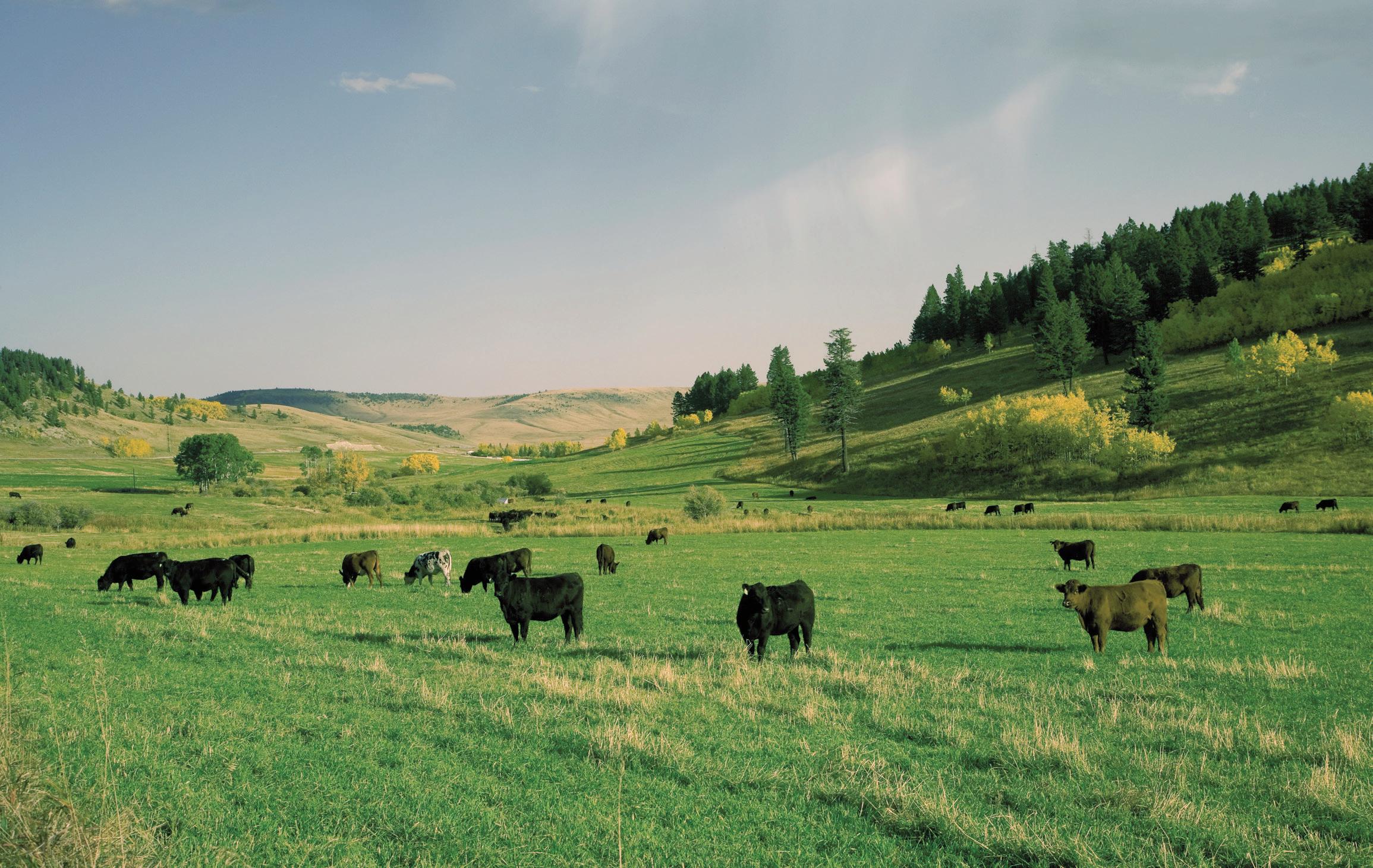
 LEE HART
LEE HART

Lynn Leavitt can go to bed each night with peace of mind knowing he is doing his part to help farmers manage an agricultural by-product while at the same time benefitting the environment.

Leavitt, who runs a commercial Black Angus beef operation about 40 km south of Belleville, ON has developed a system for collecting, compacting, and wrapping agricultural plastics to be neatly trucked to a plastic recycler.
"This product is one tool we have available that actually makes it possible to cheat nature," said Leavitt. "It is a product that allows us to put up winter feed supplies without spoilage—some people call it hay-in-a-day. It is a great tool. But then what do you do with all the used plastic? There is a lot of it, and if it is not handled properly, we run the risk of not being able to use it. So, it is important that all sectors of the agriculture industry work together to make sure it is recycled properly."
In 2016, after feeling guilt and frustration that no proper recycling systems were available for the agricultural plastic used on his farm, Leavitt designed and built what was later called the Pac-It compactor. It is a relatively low-cost but effective way to handle used plastic so it can be recycled.

His efforts in developing the Pac-It compactor and promoting agriculture plastic recycling over the years earned him recognition as the Beef Farmers of Ontario’s 2023 nominee for The Environmental Stewardship Award (TESA).
The compactor is a slated, wooden "crib" with an open top and bottom that fits on a conventional wooden pallet. The idea is to
put clean, used plastic wrap inside the crib, compress it, and compact it inside the crib until it is full. The bundle is tied with several wraps of plastic bale twine. Voila, you have a 1,000-pound bundle of used agricultural plastic ready to be shipped to the recycler.
As Leavitt came up with the design for the Pac-It compactor, he created a company—U-Pac AgriService, to help market the compactor and promote the idea of recycling agricultural plastic to other producers. You can learn more about the company and compactor on the U-Pac AgriService Facebook page. His main interest is to raise awareness among producers that there are better options for handling agricultural plastic.
As the fourth generation operating the family farm, Leavitt runs a herd of about 100 head of commercial Black Angus cows. He keeps all his calves for backgrounding and finishing. He works with a local abattoir to have roughly
18-month-old finished animals processed. He supplies some meat products to local restaurants, and two other retailers carry Leavitt Black Angus Beef meat products.
The Prince Edward County farming operation includes 200 acres of deeded land and another 300 acres of rented land. Of all the acres, about 175 acres are used for grazing cows and calves. Stored feed for the cattle includes dry hay, baleage (high-moisture hay bales wrapped in 500-foot-long plastic tubes), corn silage stored in 10foot diameter, 200-foot-long silage bags, and grain corn. That plastic is a key part in storing the feed supply for the year, "but there was no practical way to deal with the used material," said Leavitt. He connected with a local plastic manufacturing company in Belleville, and while they weren't involved in recycling, it led Leavitt to connect with a recycling operation in London, ON. They were willing to take clean agricultural plastic collected from within a
three-hour driving radius of their plant if it could be assembled and transported economically.

That led Leavitt to design the Pac-It compactor to bundle the plastic in a neat, dense package that could be economically trucked. Each bundle from the compactor weighs about 1,000 pounds. As other farmers in the Quinte Region got involved, they too began to bundle agricultural plastic.
The farmers bring their bundled plastic to the Leavitt farm. When there are enough bundles to warrant a load to the recycler, Leavitt brings the bundles to the warehouse of a local agricultural plastic retailer, where they are loaded onto the recycler's trailer.
Over the years, the plastic recycling system has sent about 225,000 pounds of plastic to the recycling plant, of which about 30,000 has come from the Leavitt farm.
He is always interested in getting the recycling message out to other producers. He has presented
at several events, including the London Farm Show, Ontario Forage Council, Beef Farmers of Ontario and Peterborough Soil and Crop Association. He has also been involved with and received support from CleanFARMS, a not-for-profit industry stewardship organization led by the plant science industry. CleanFARMS is committed to environmental responsibility by properly managing agricultural waste products such as empty agricultural pesticide and fertilizer containers, grain bags, seed and pesticide bags and other agricultural plastics.
"To be able to recycle and repurpose plastics cost-effectively and efficiently, farmers, local municipalities, other levels of government, and industry players must work together to set up a recycling system on a local or regional basis," explained Leavitt. "This can be a challenge since farmers tend to be naturally independent, so it will require a change in thinking. They need to understand it takes a small investment of time and resources to handle plastics correctly.
"It is great to see this plastic being recycled and repurposed into other plastic products, but I believe where the idea will really gain traction is when the used plastic is converted to biofuel, and that can be done," he said. "Then we will have a system that goes full circle. The used plastic is made into biofuel, the biofuel is used to power the farm tractor that is putting up feed into plastic bags and tubes, and then that used plastic will be used again to produce more biofuel. It will be one more way to reduce the carbon footprint of agriculture."


Canadian grasslands under the care of beef farmers and ranchers store 1.5 billion tonnes of carbon. Scan QR code to learn more.
Brought to you by

FACT
STORY COURTESY OF CANADIAN CATTLE ASSOCIATION
FOOD HEROES & FEEL GOOD RECIPES ADVERTORIAL September • 2023
LYNN LEAVITT © COURTESY OF CANADA BEEF



September • 2023 globalheroes.com





















































































































































 RECIPE BY THE BRUNETTE BAKER FOR MUSHROOMS CANADA
RECIPE BY THE BRUNETTE BAKER FOR MUSHROOMS CANADA









 LEE HART
LEE HART












































